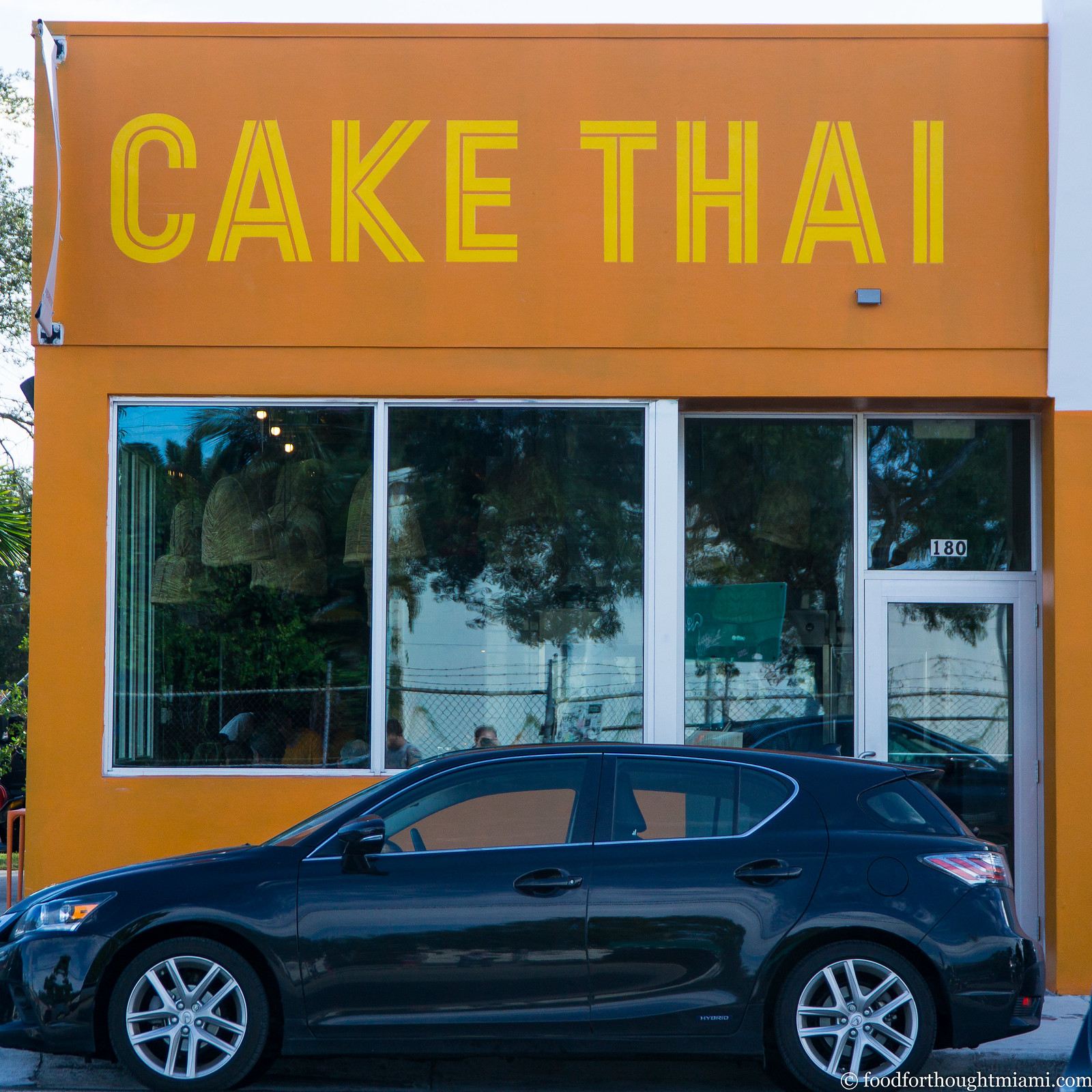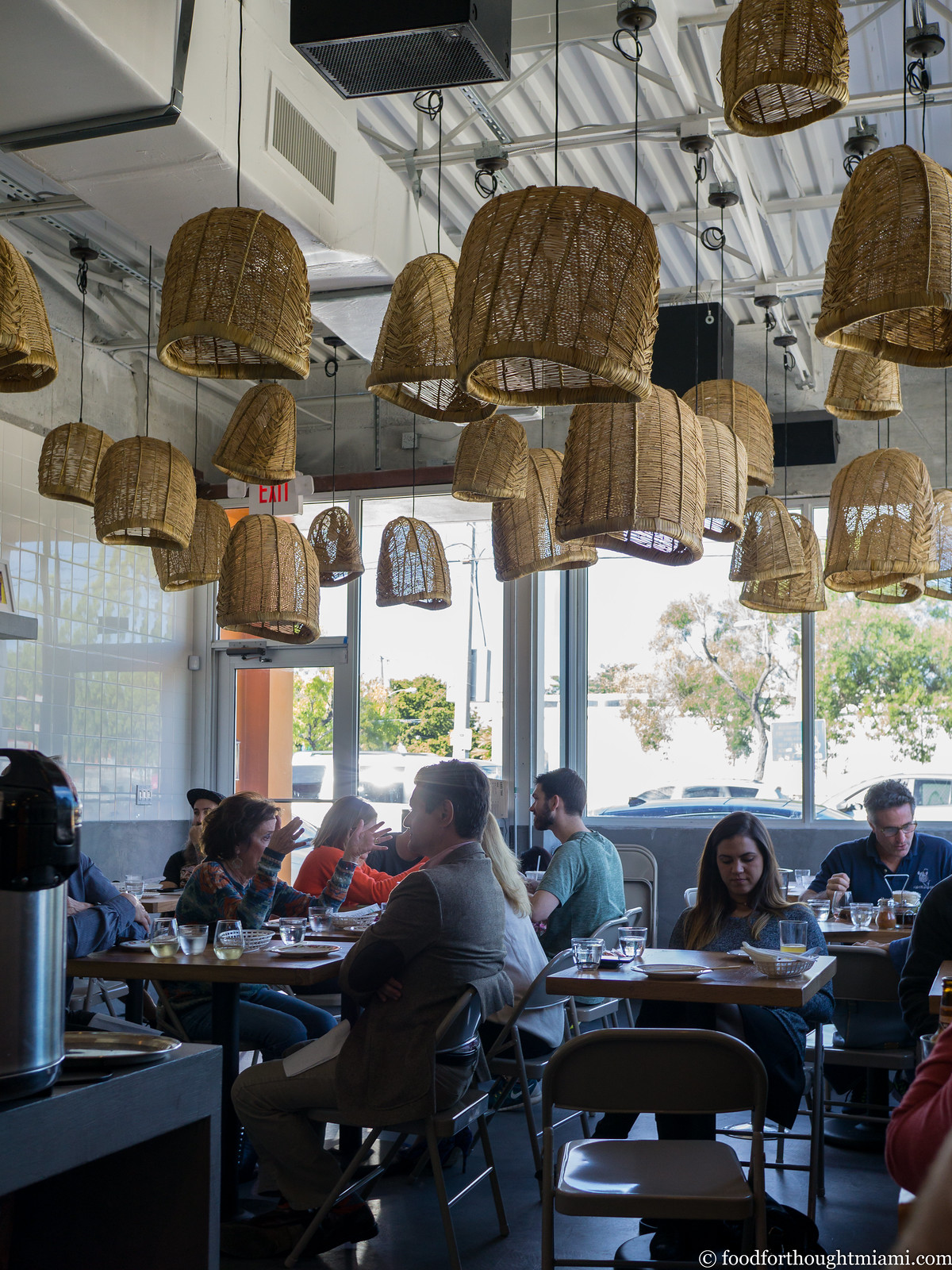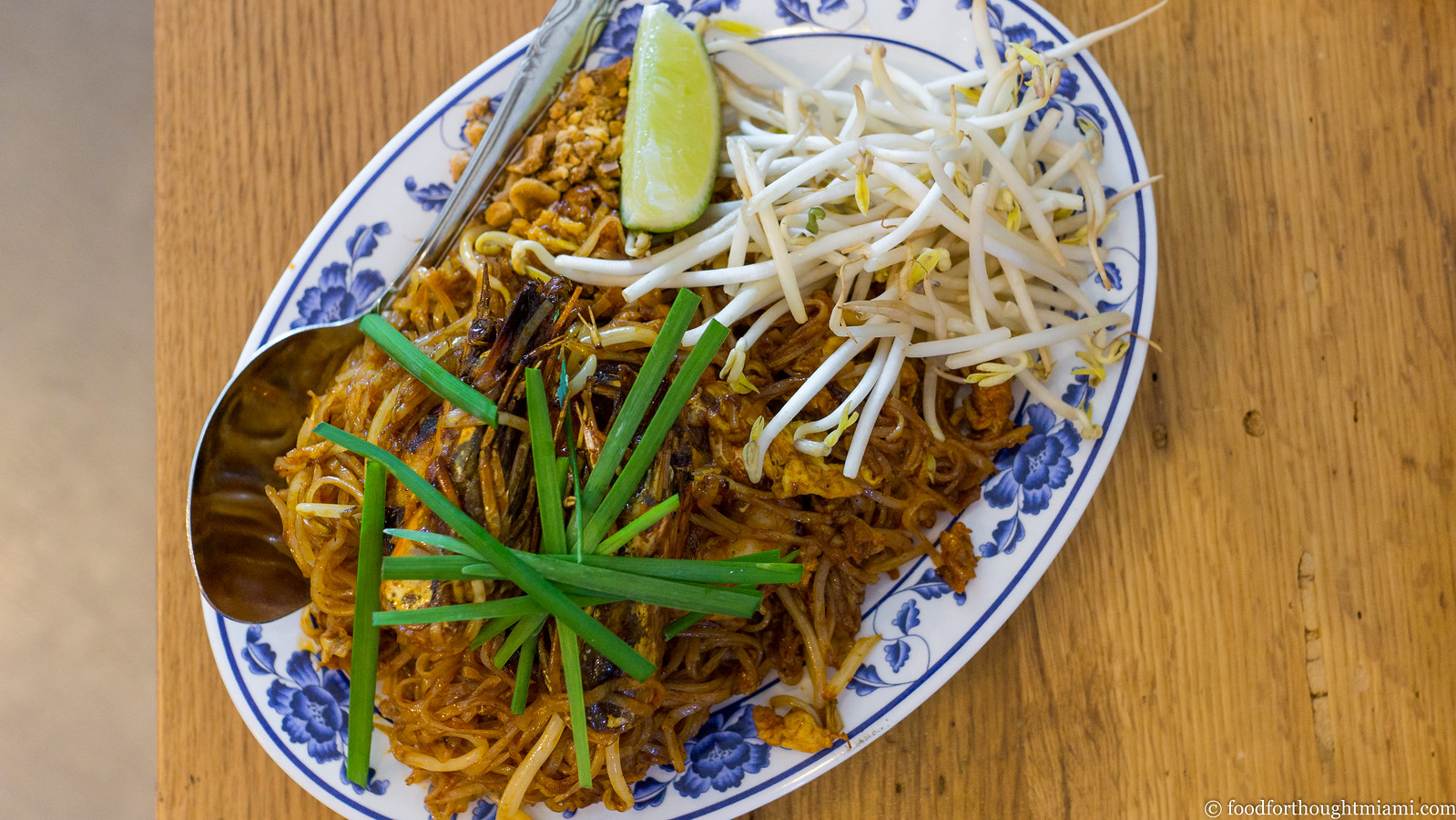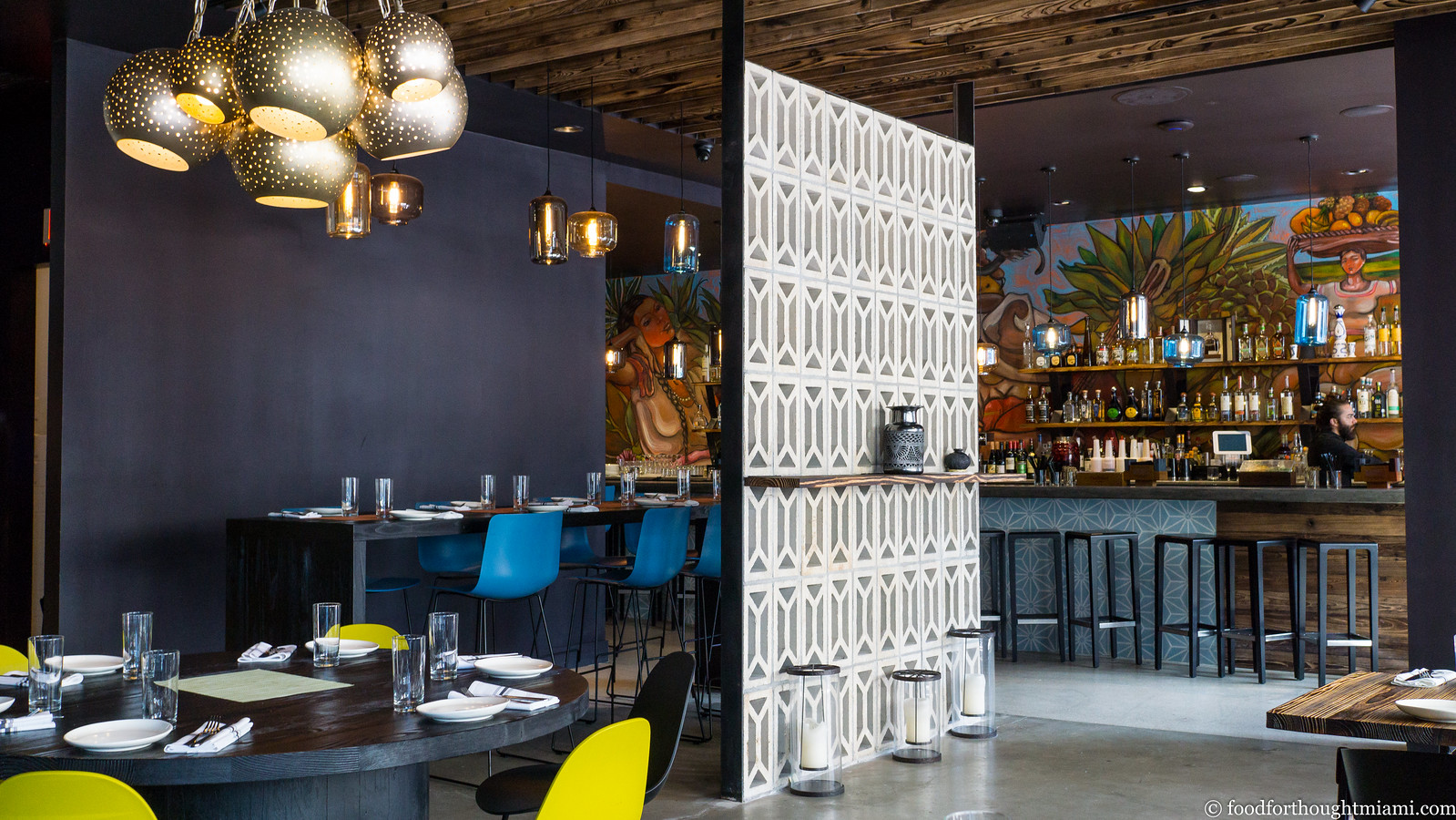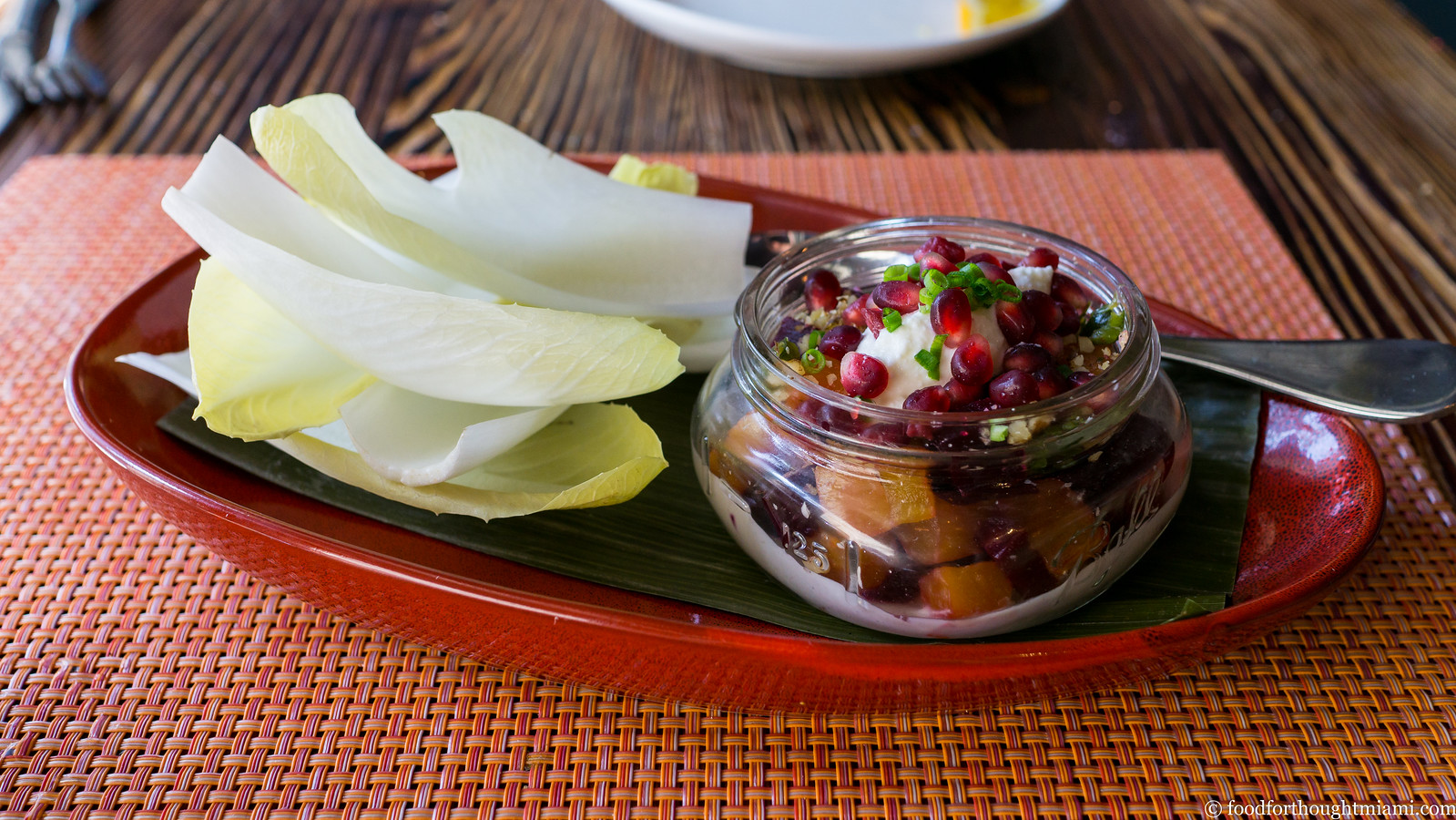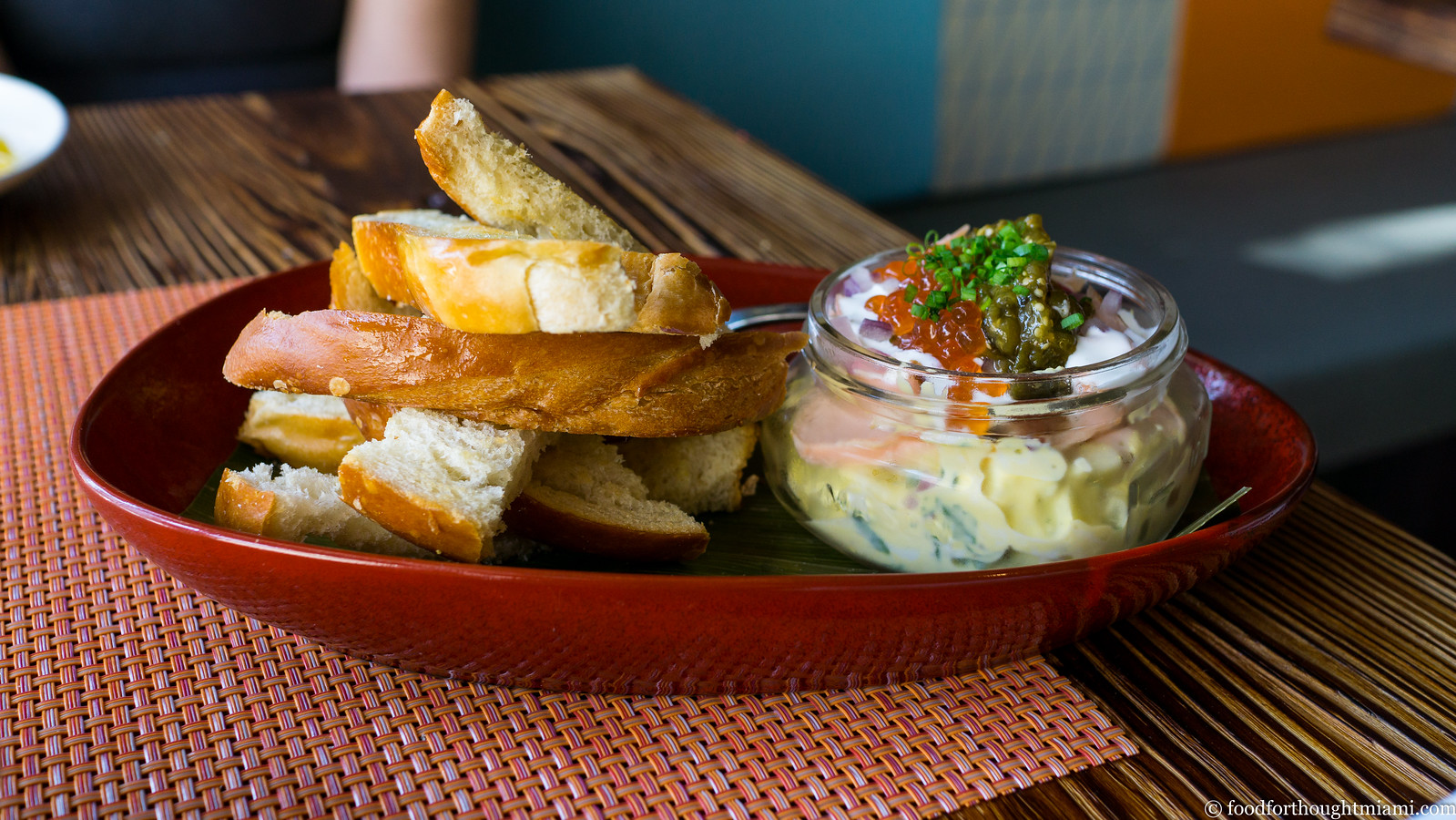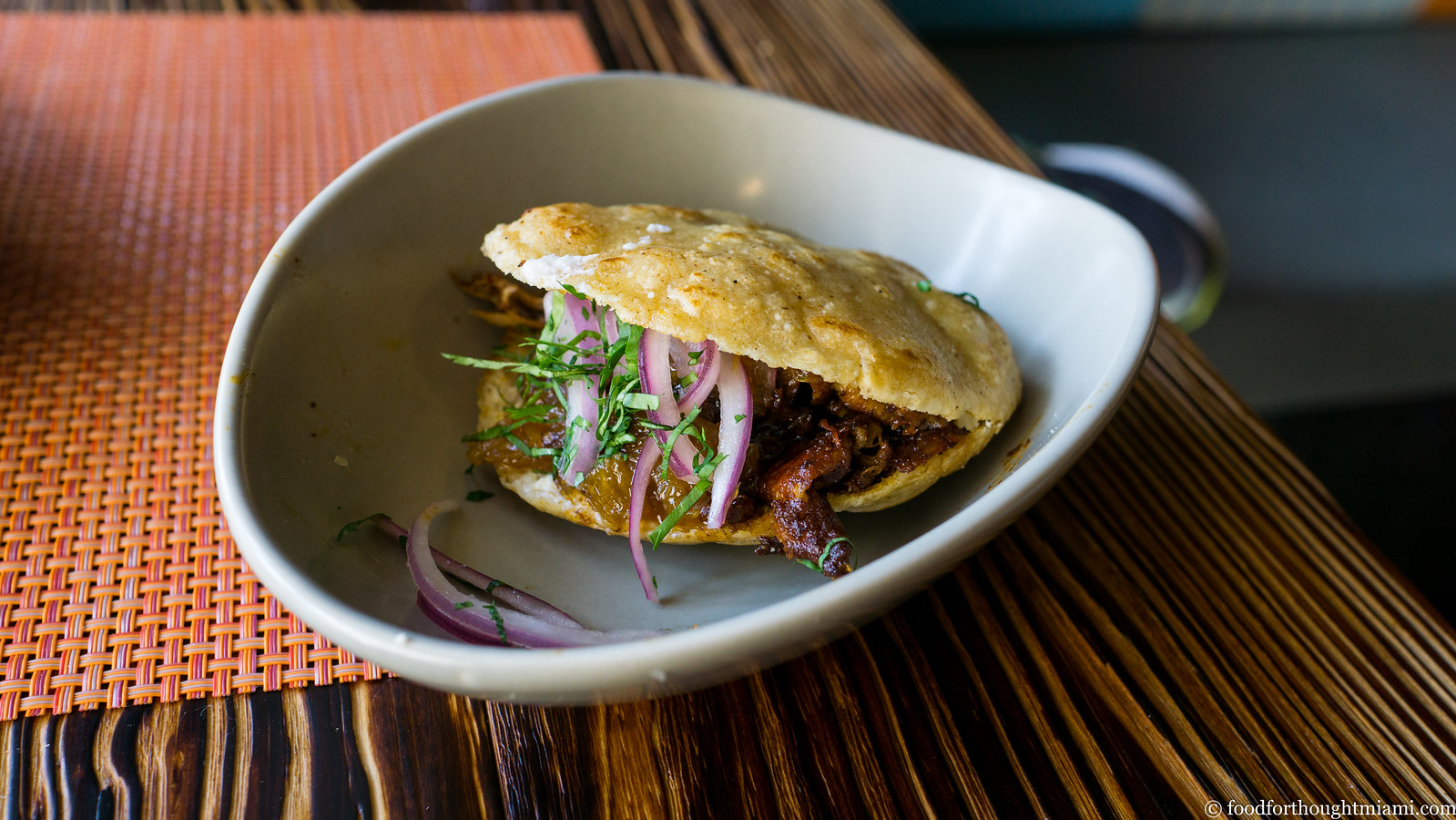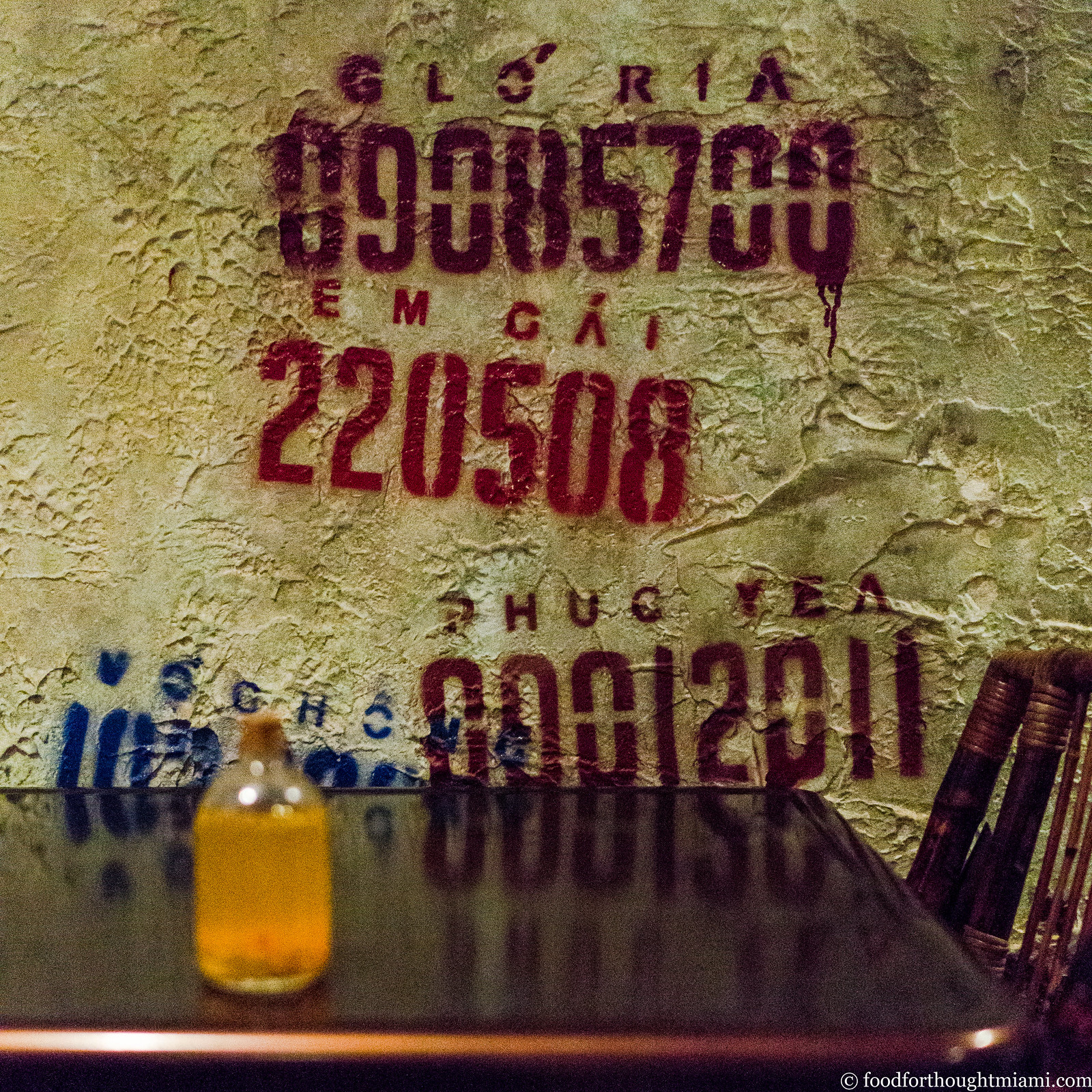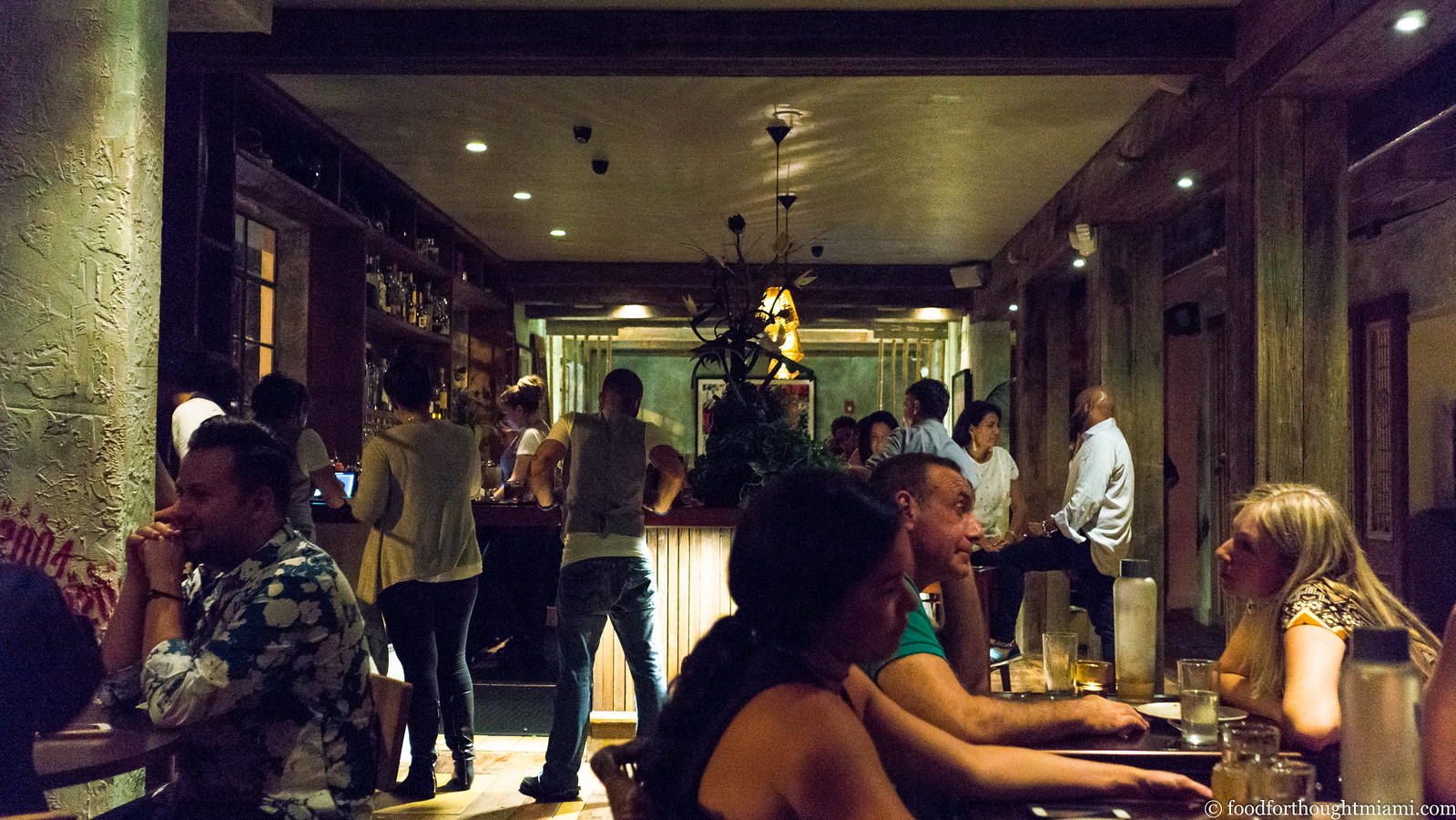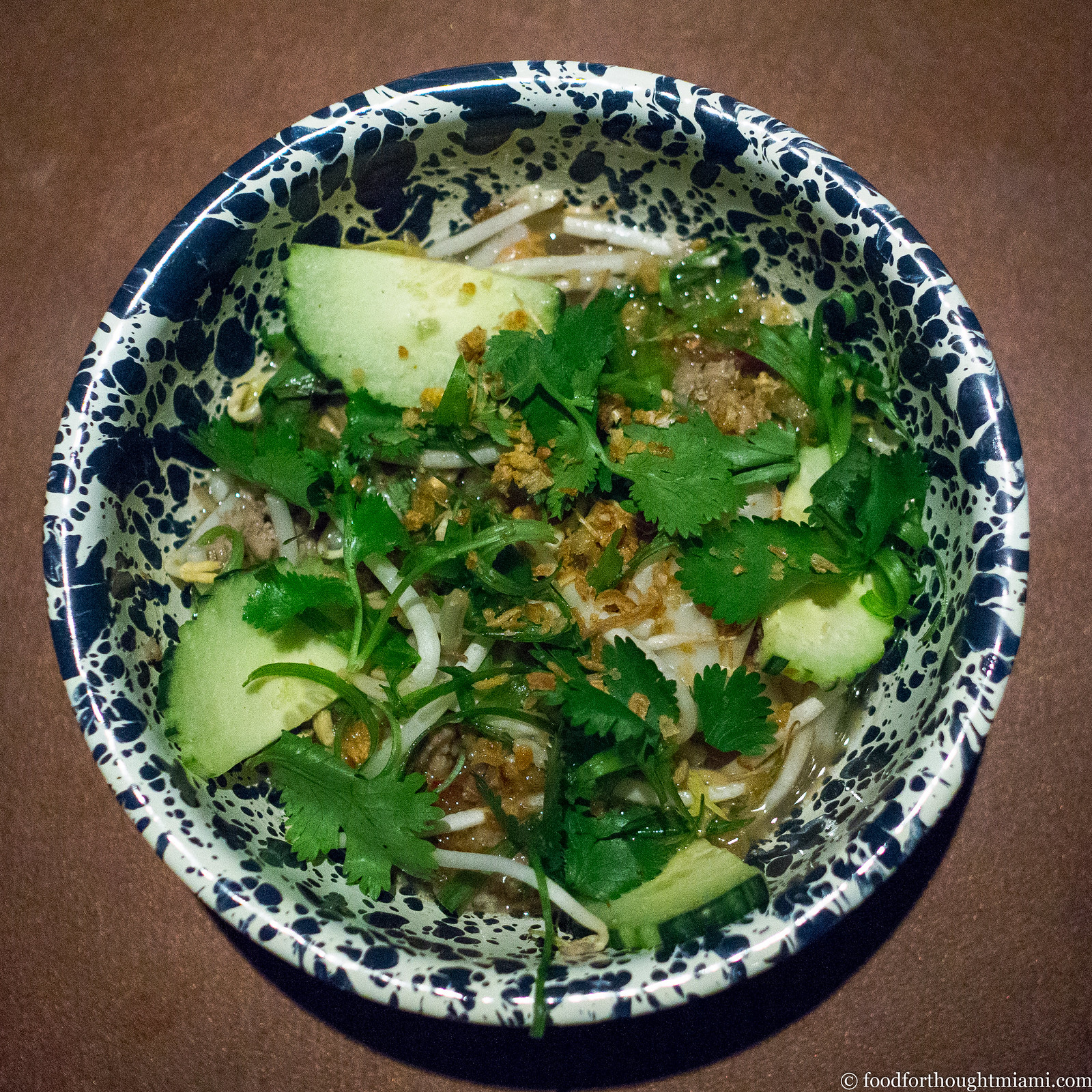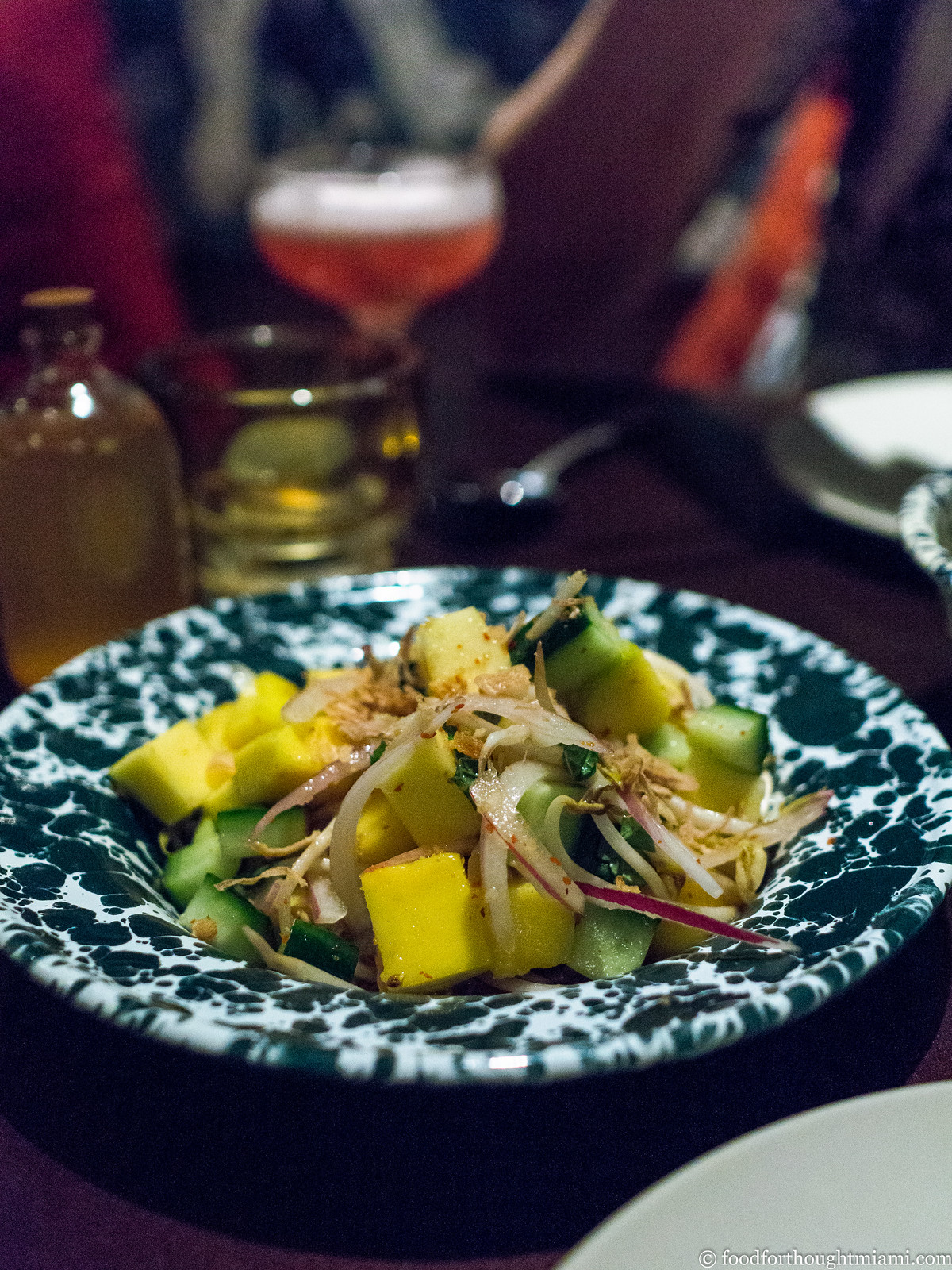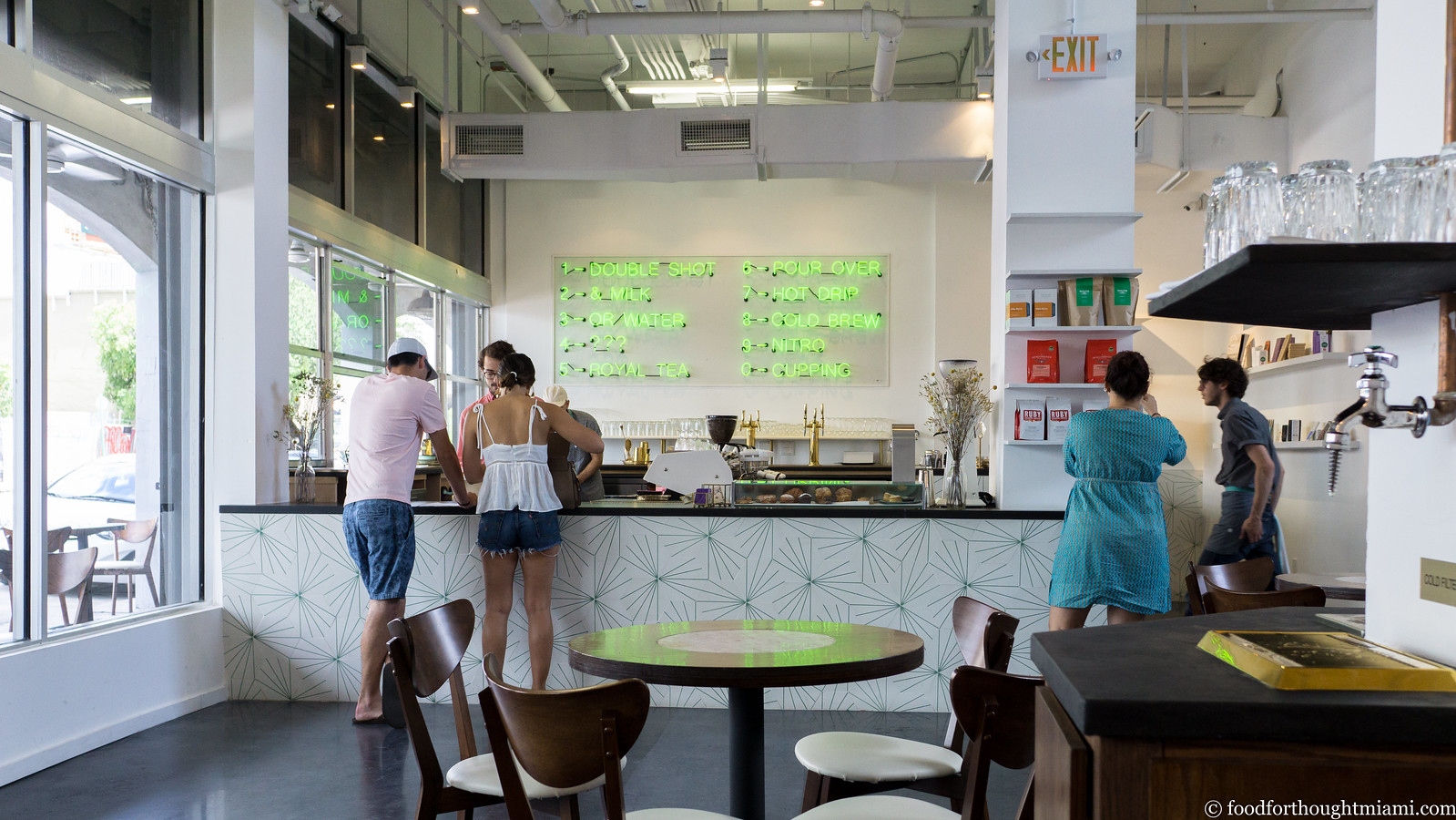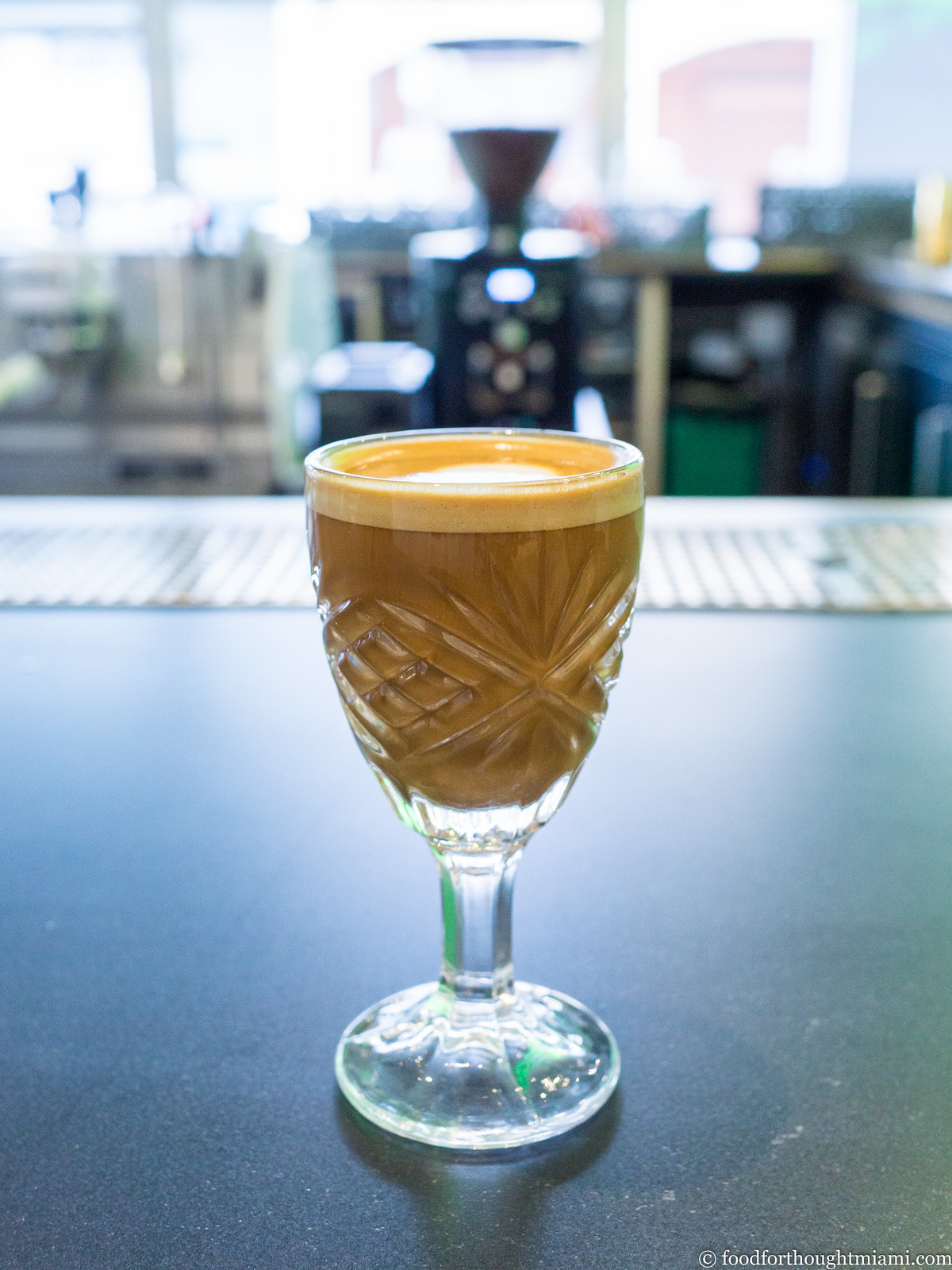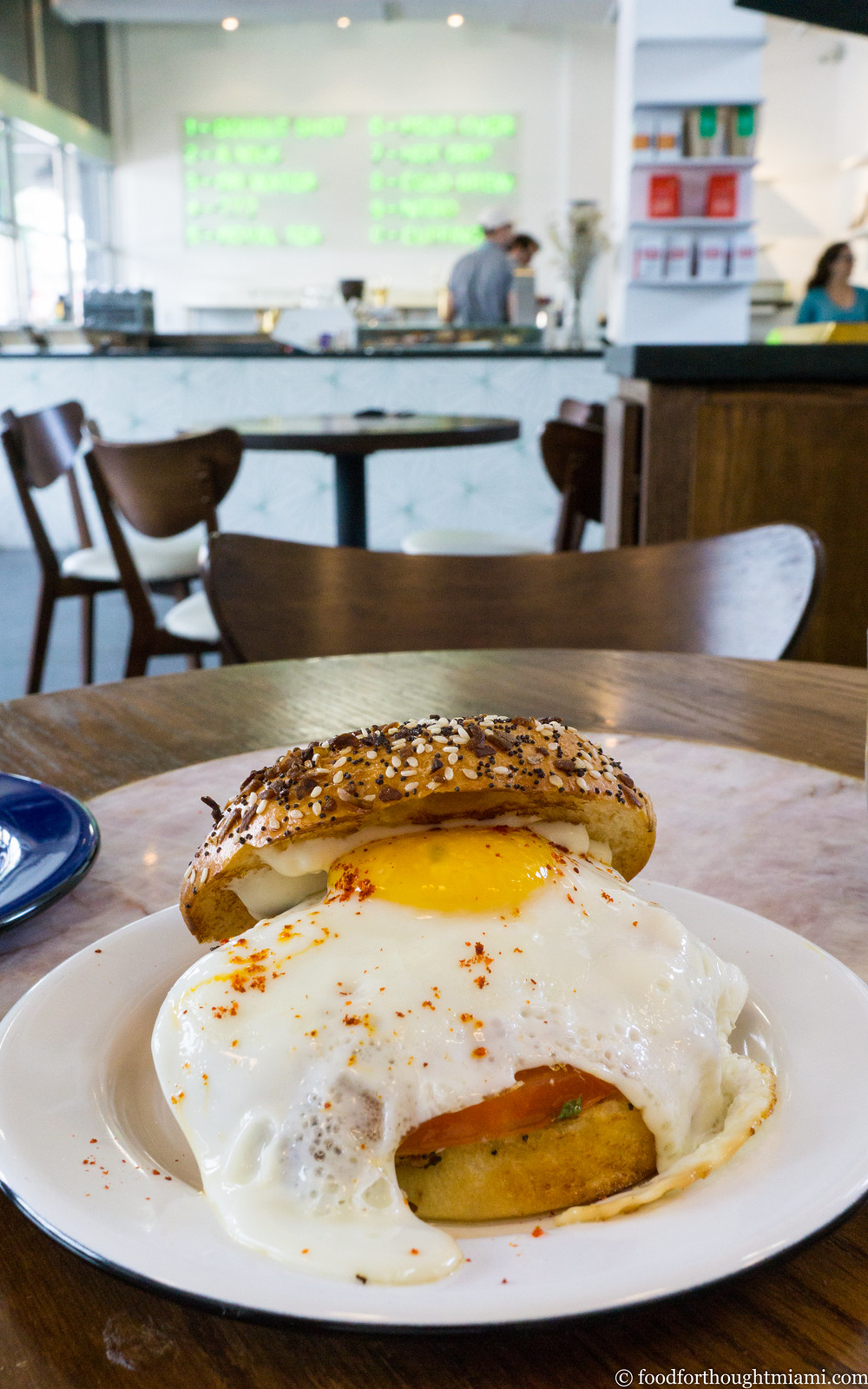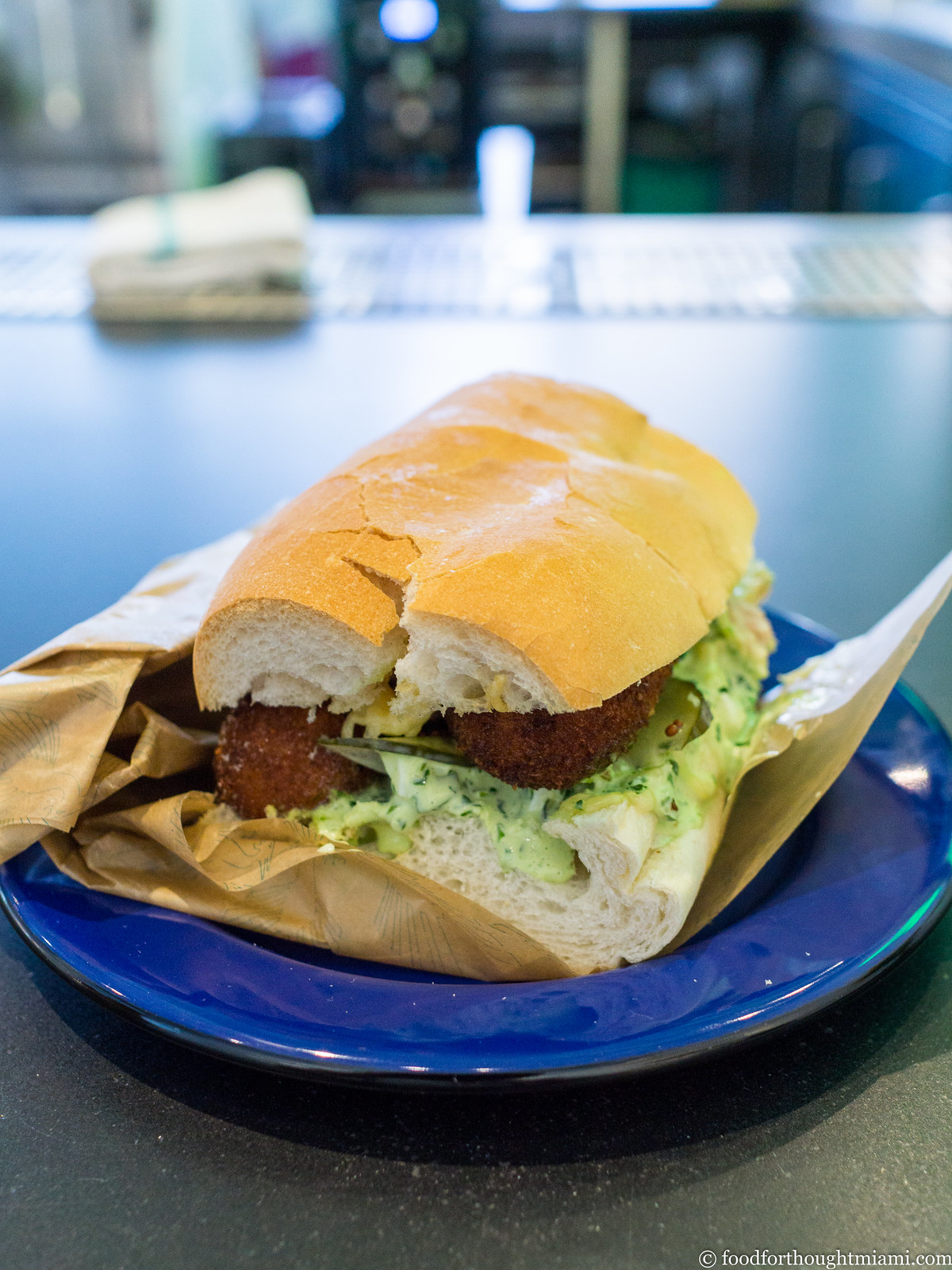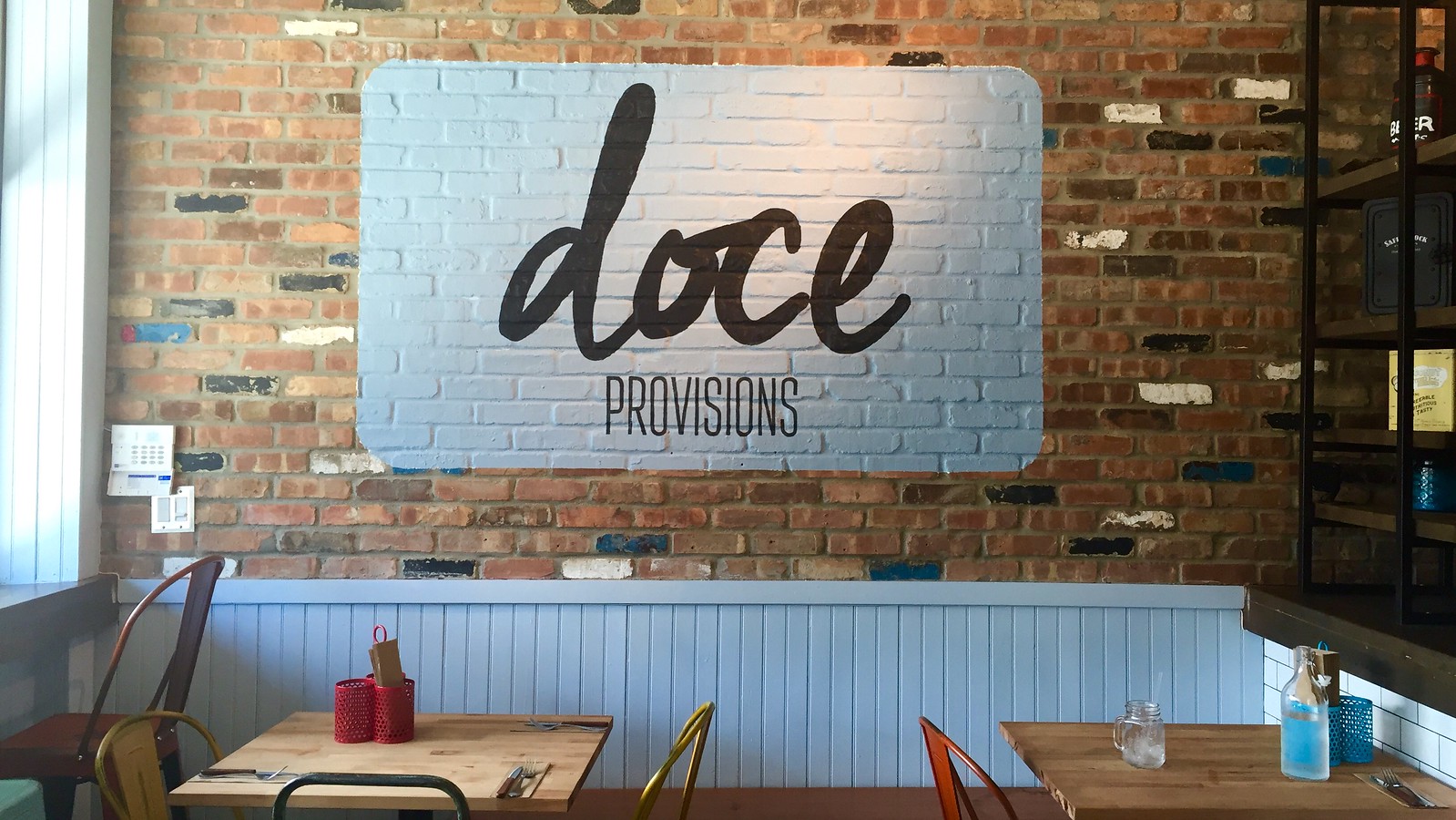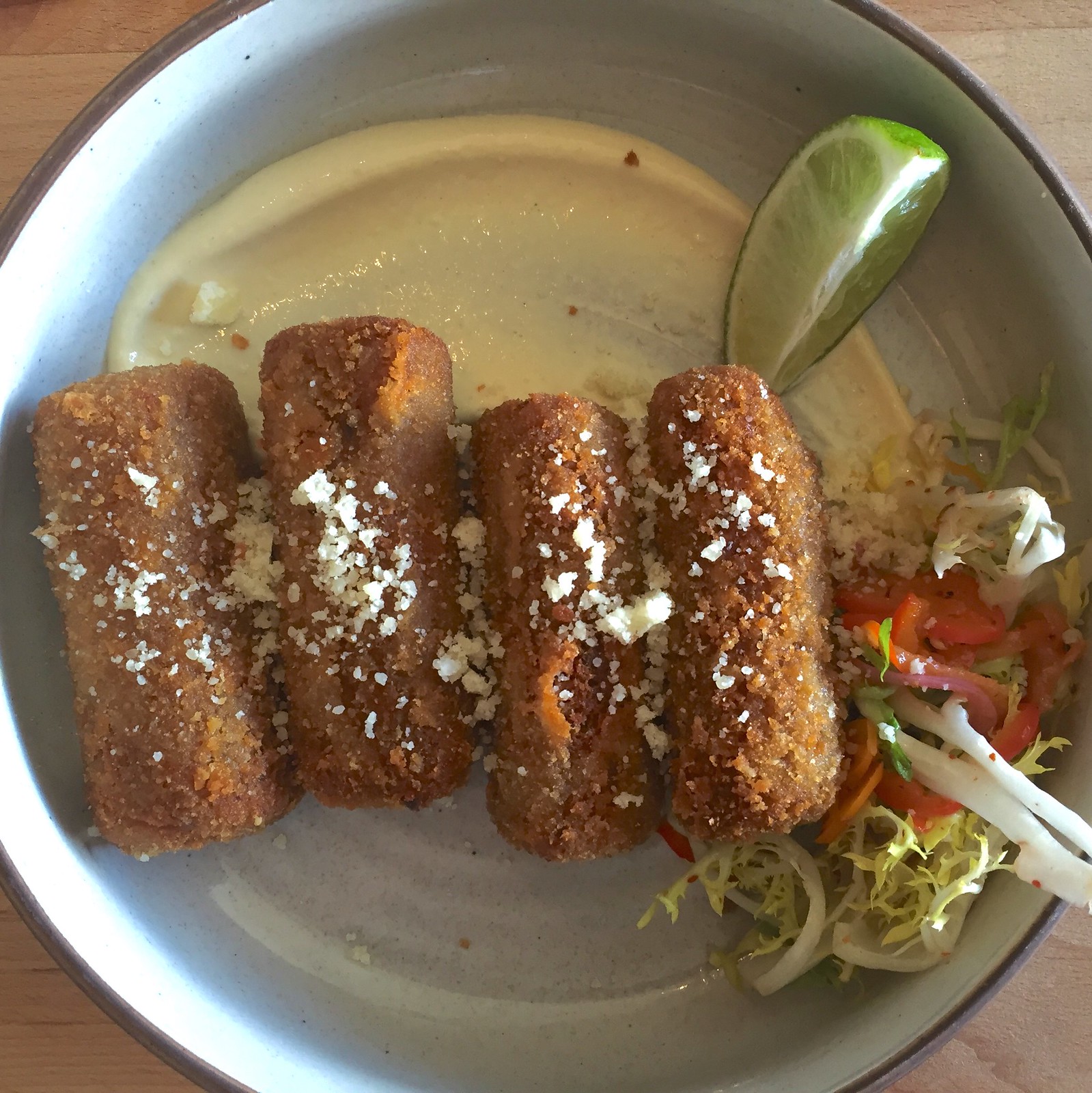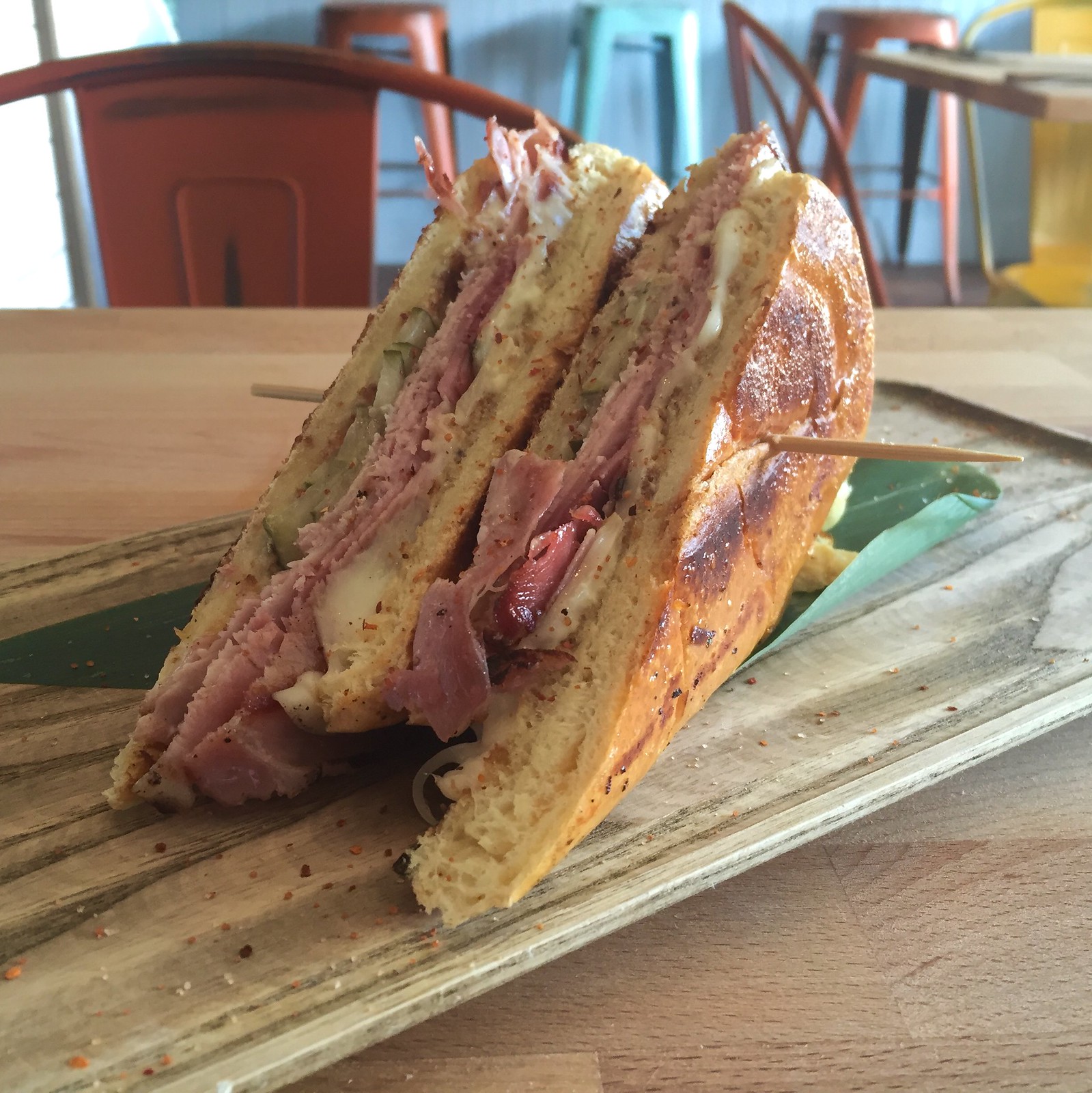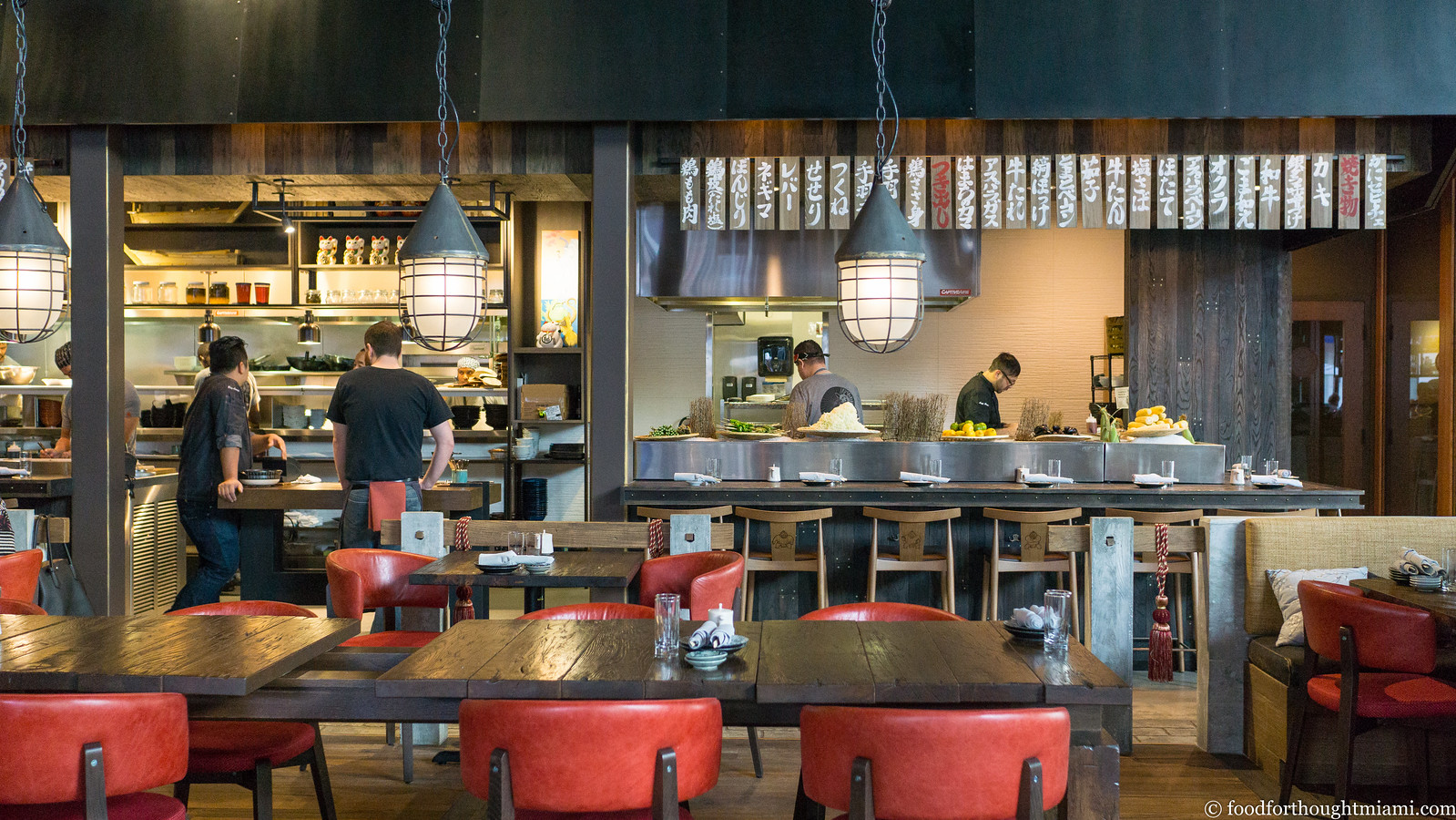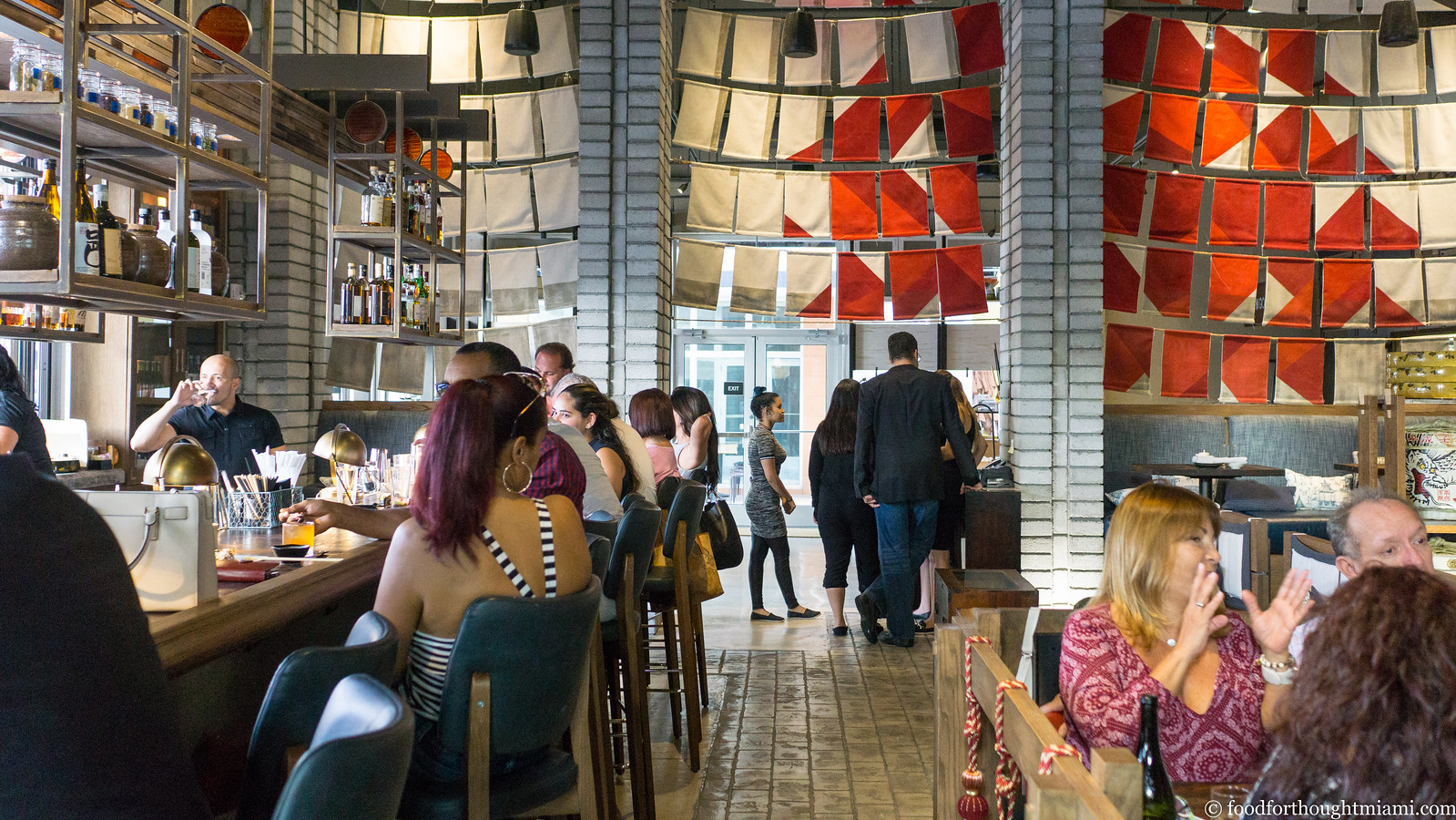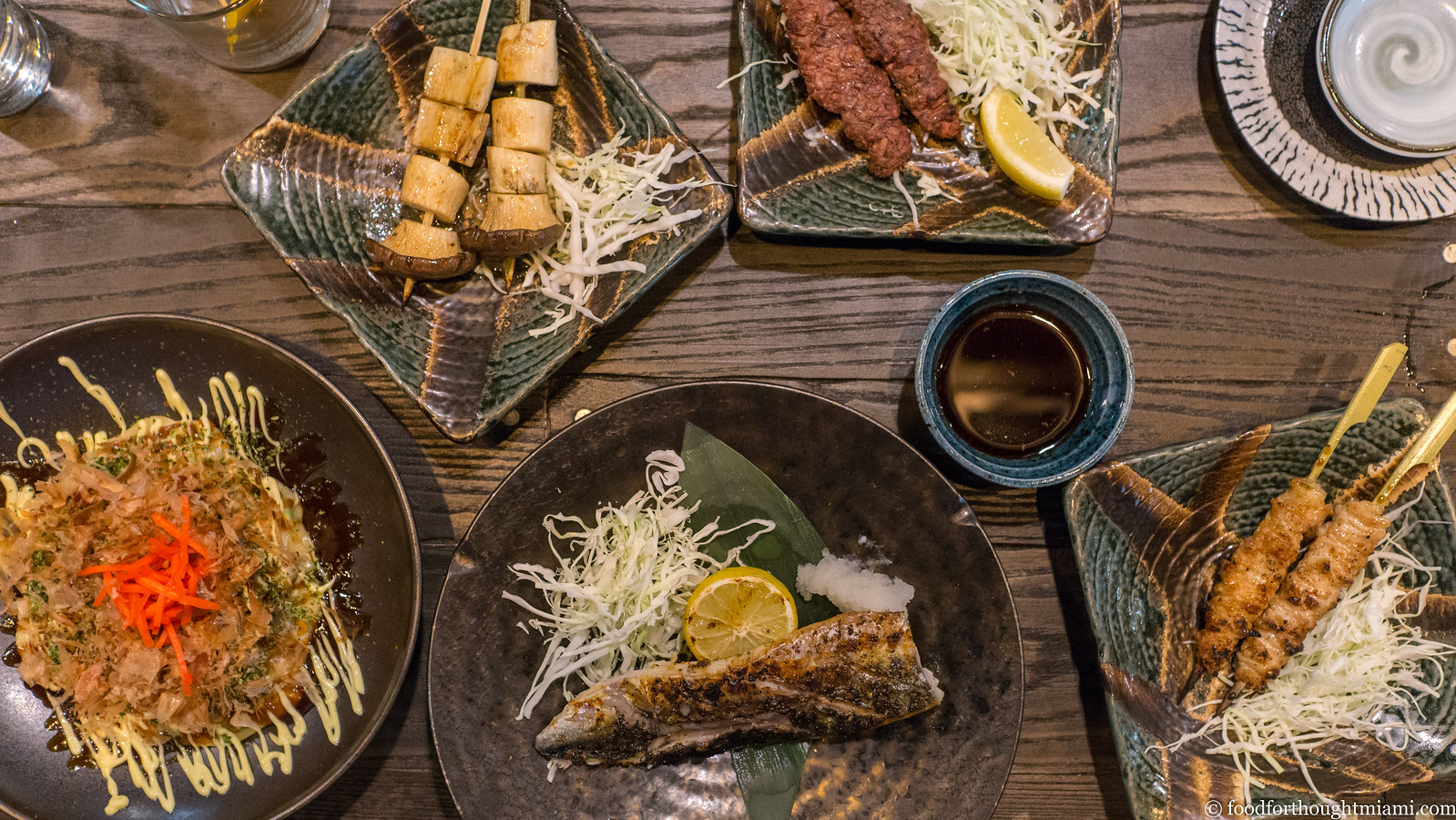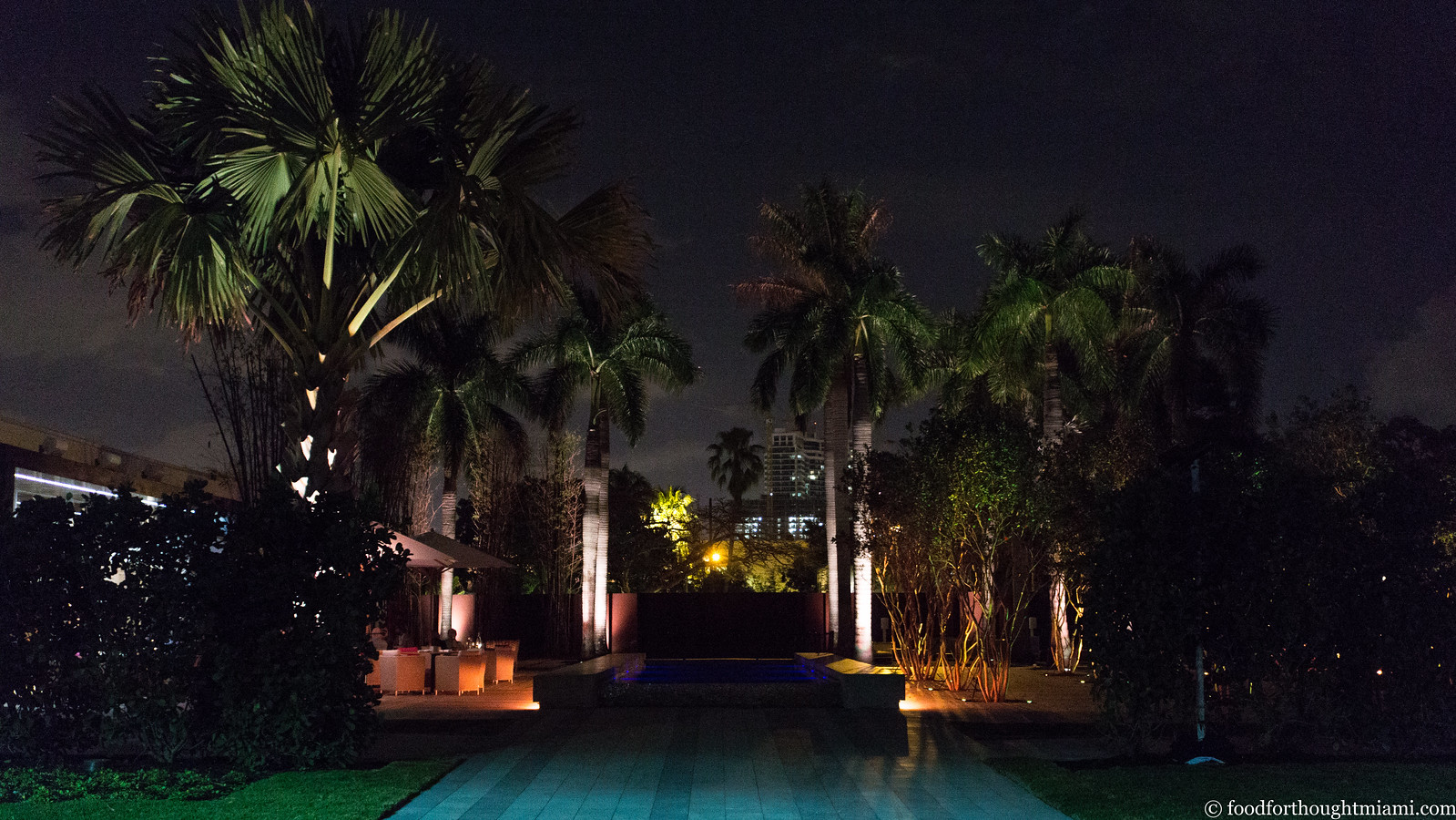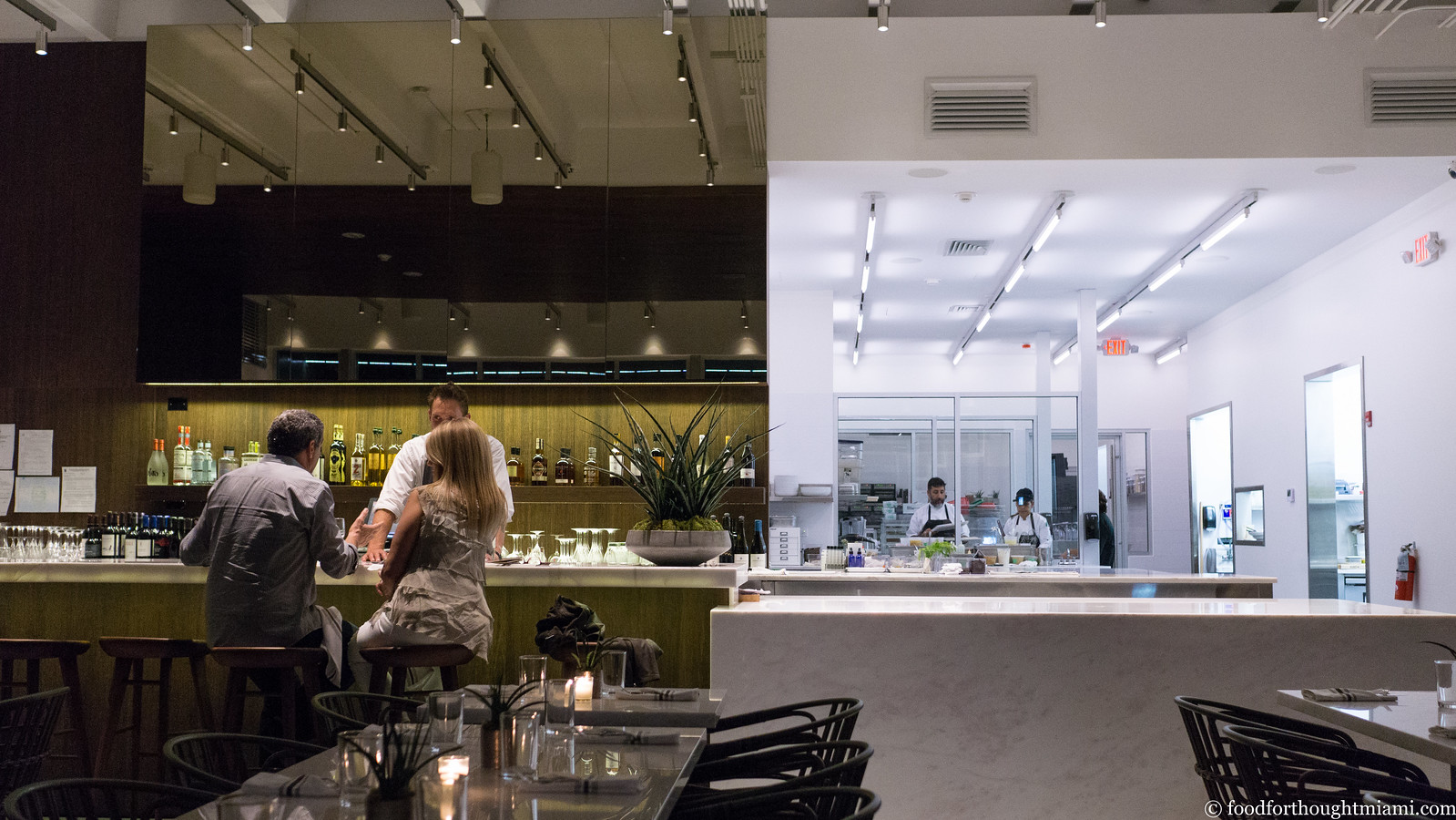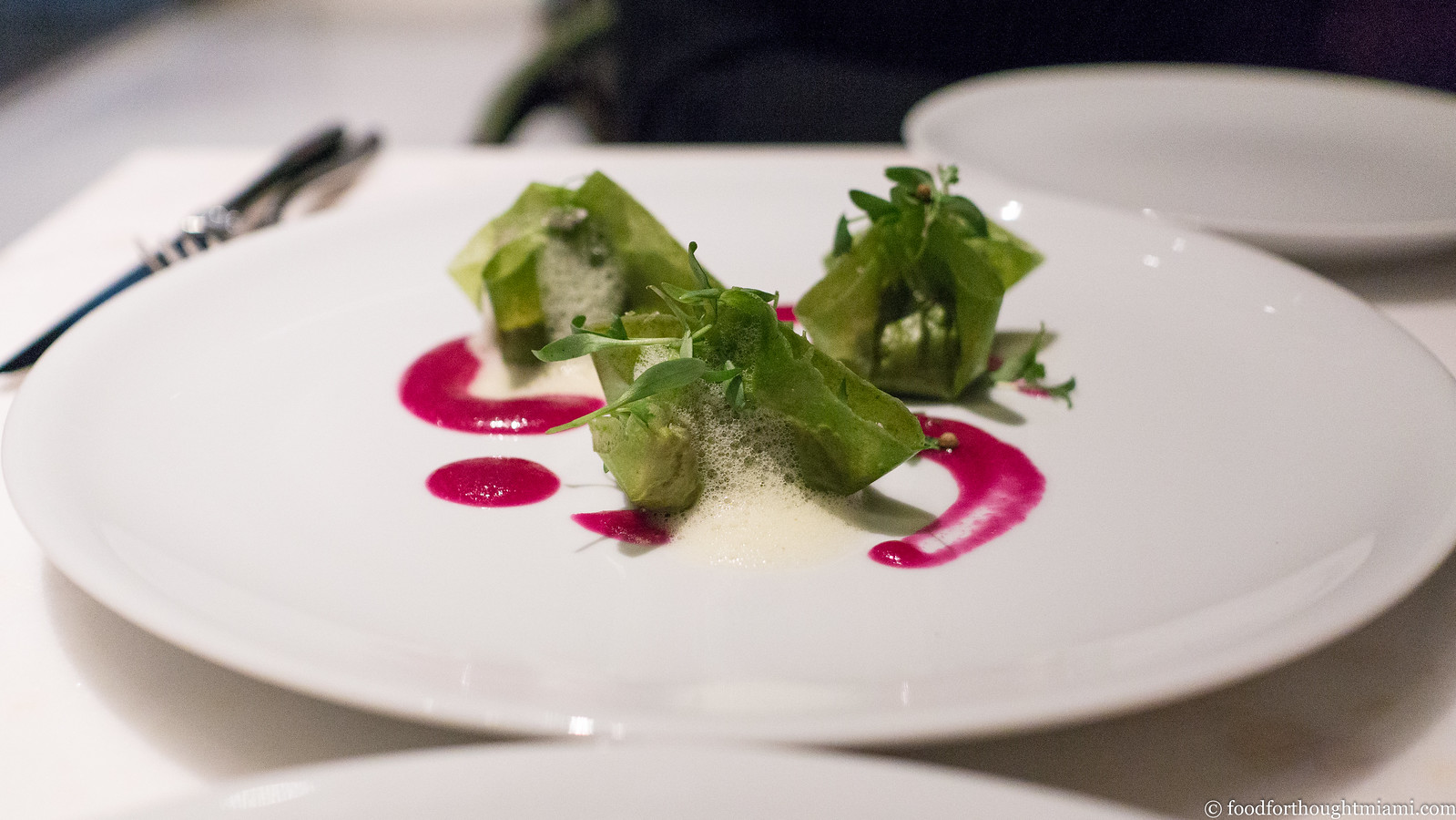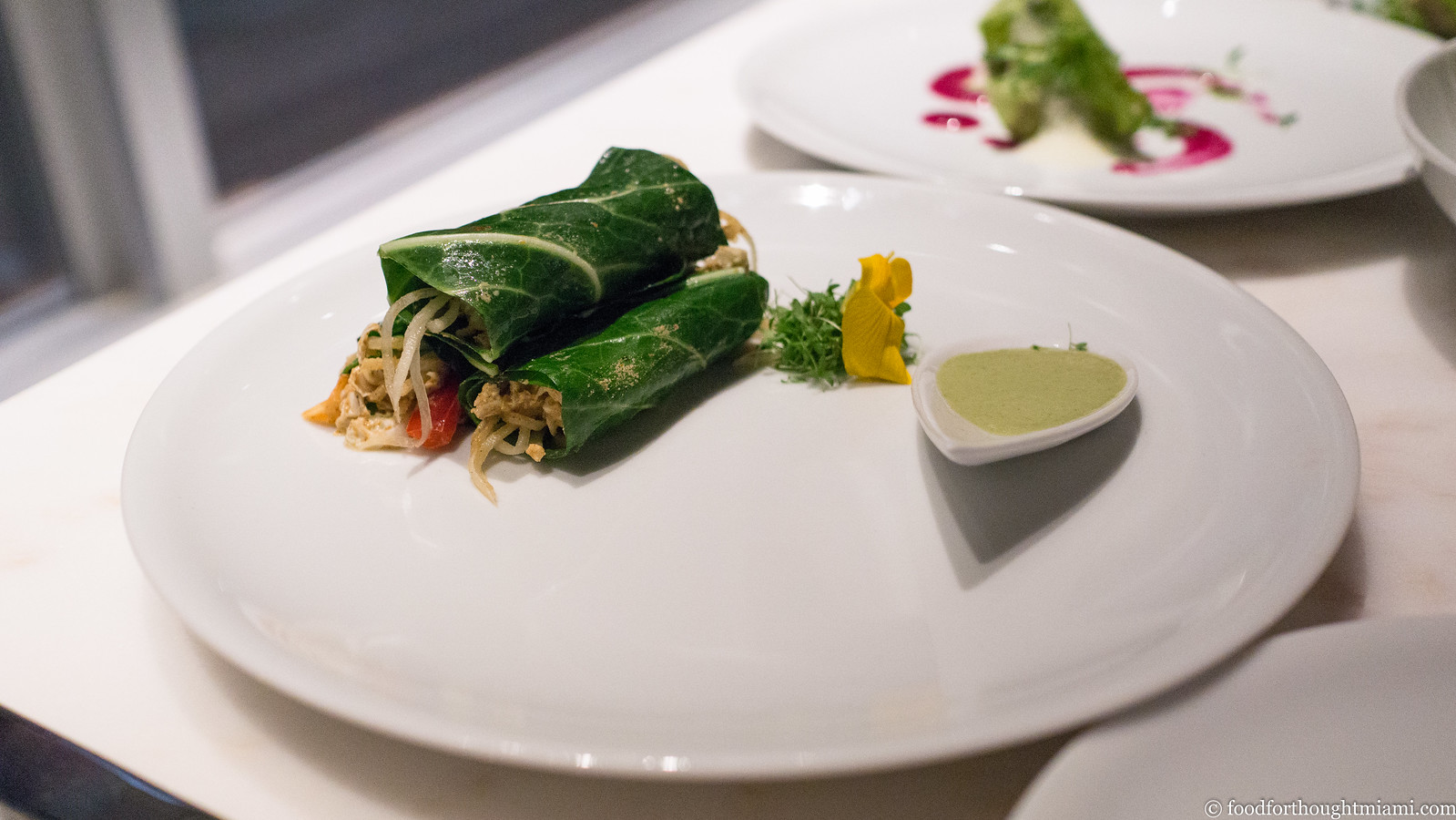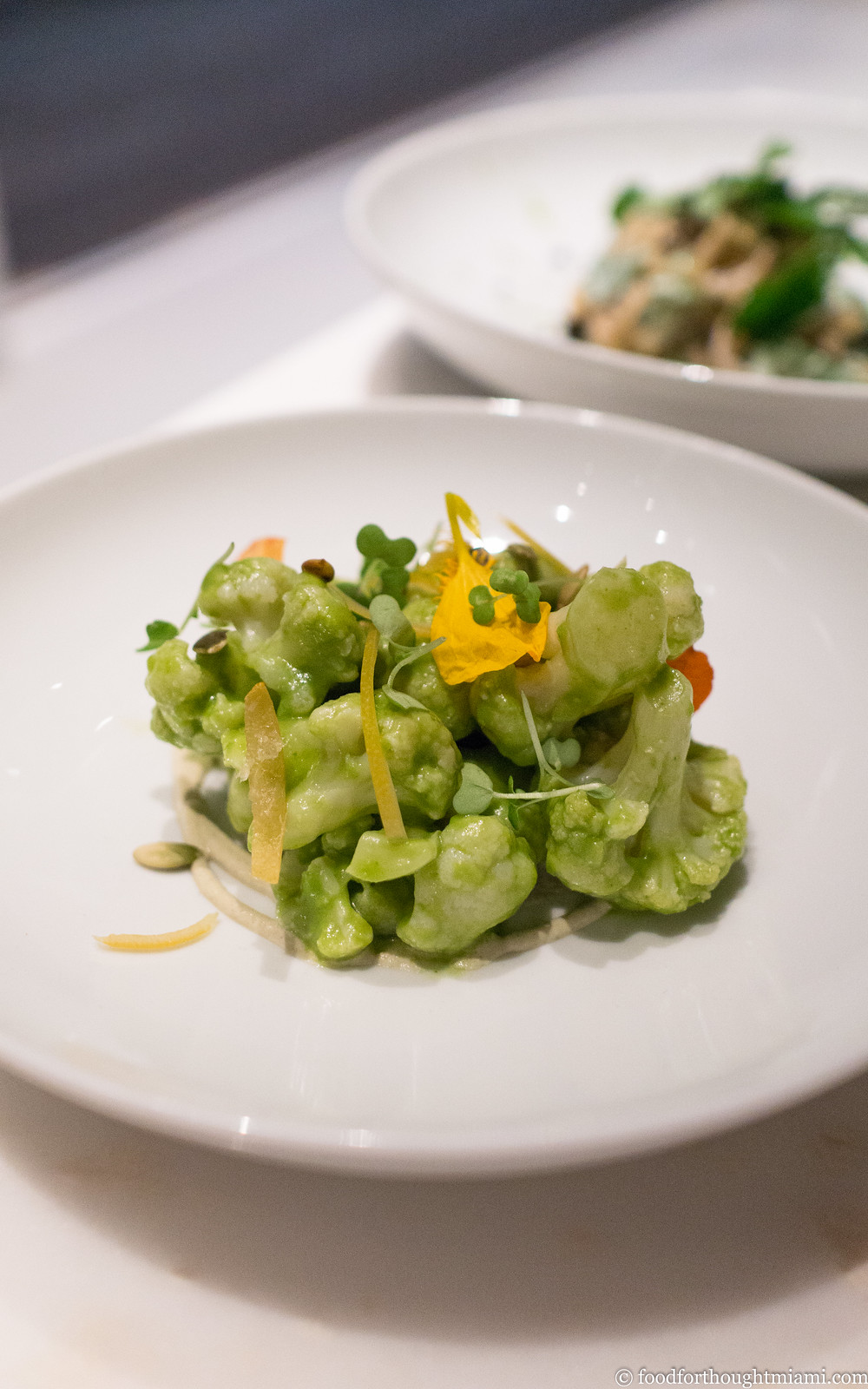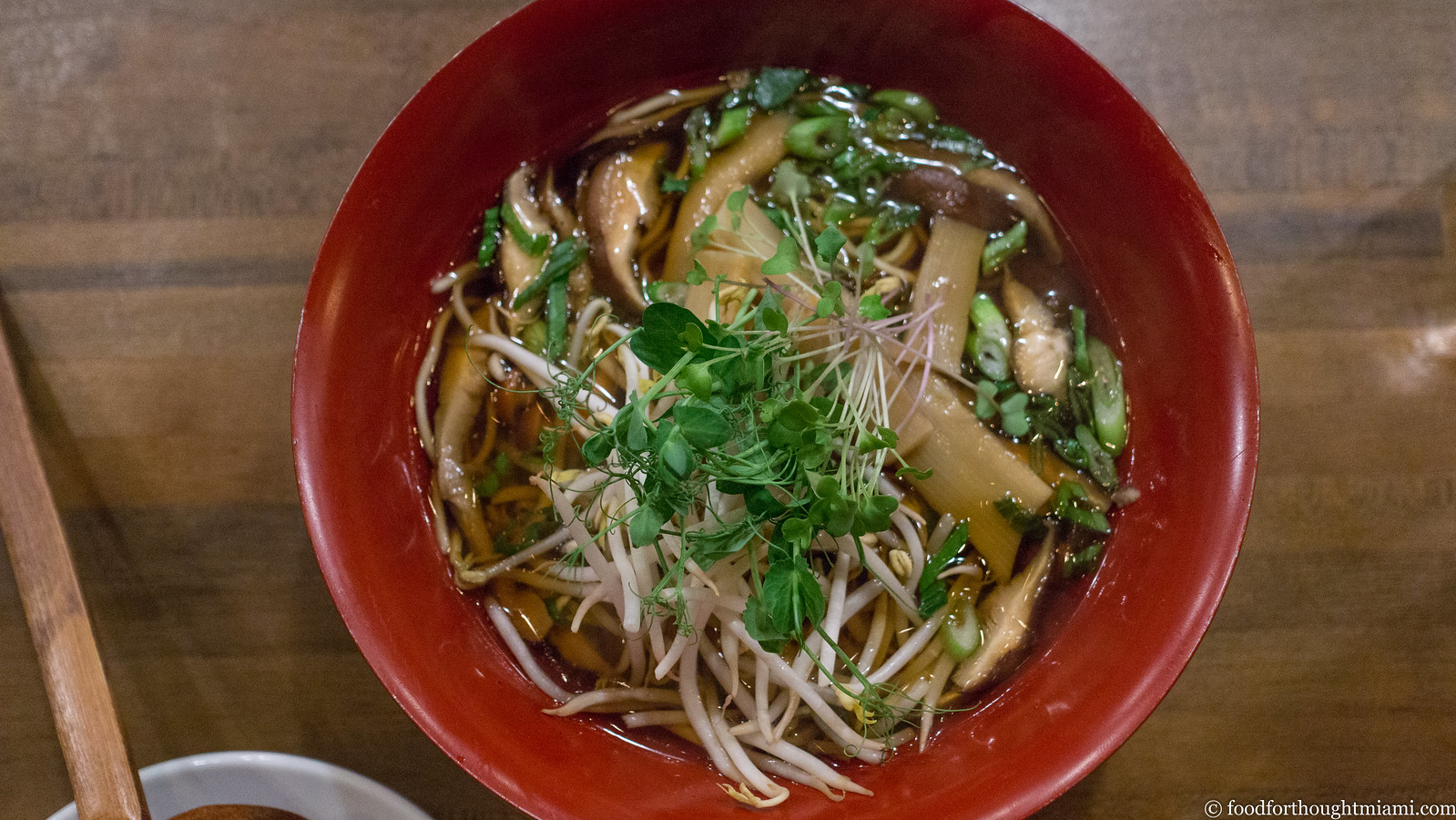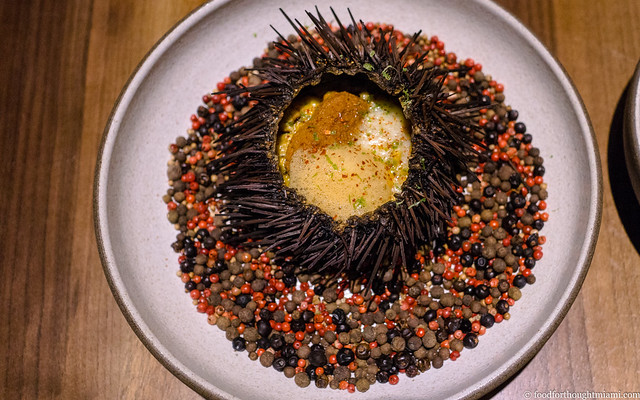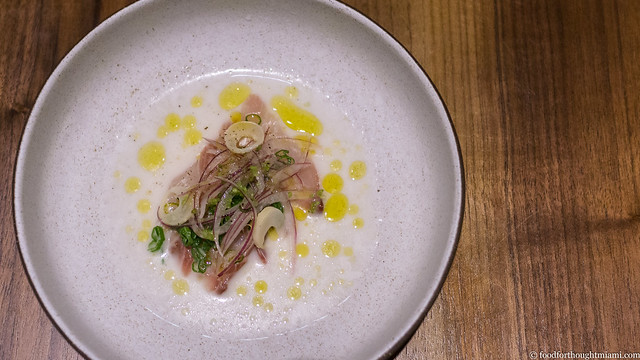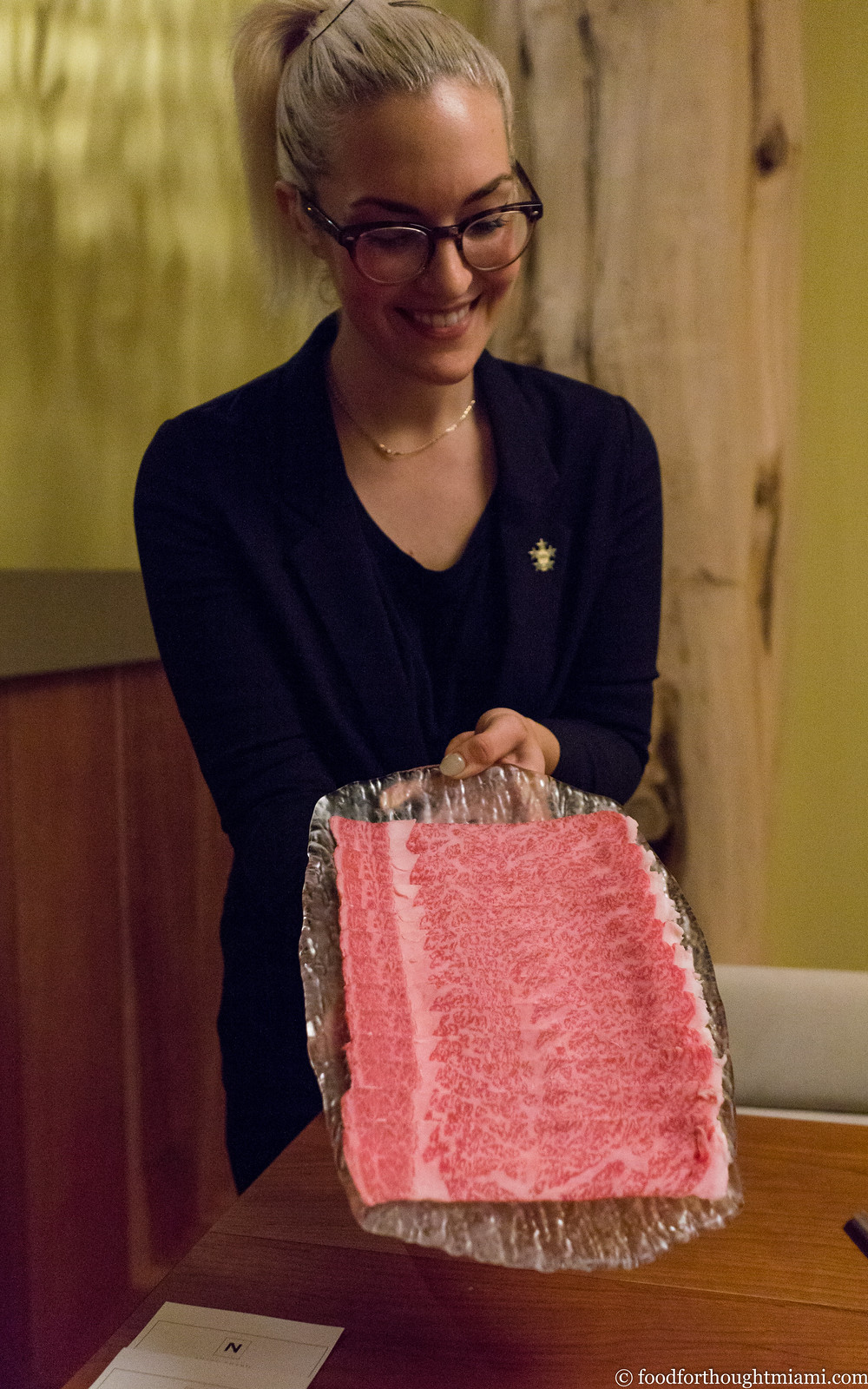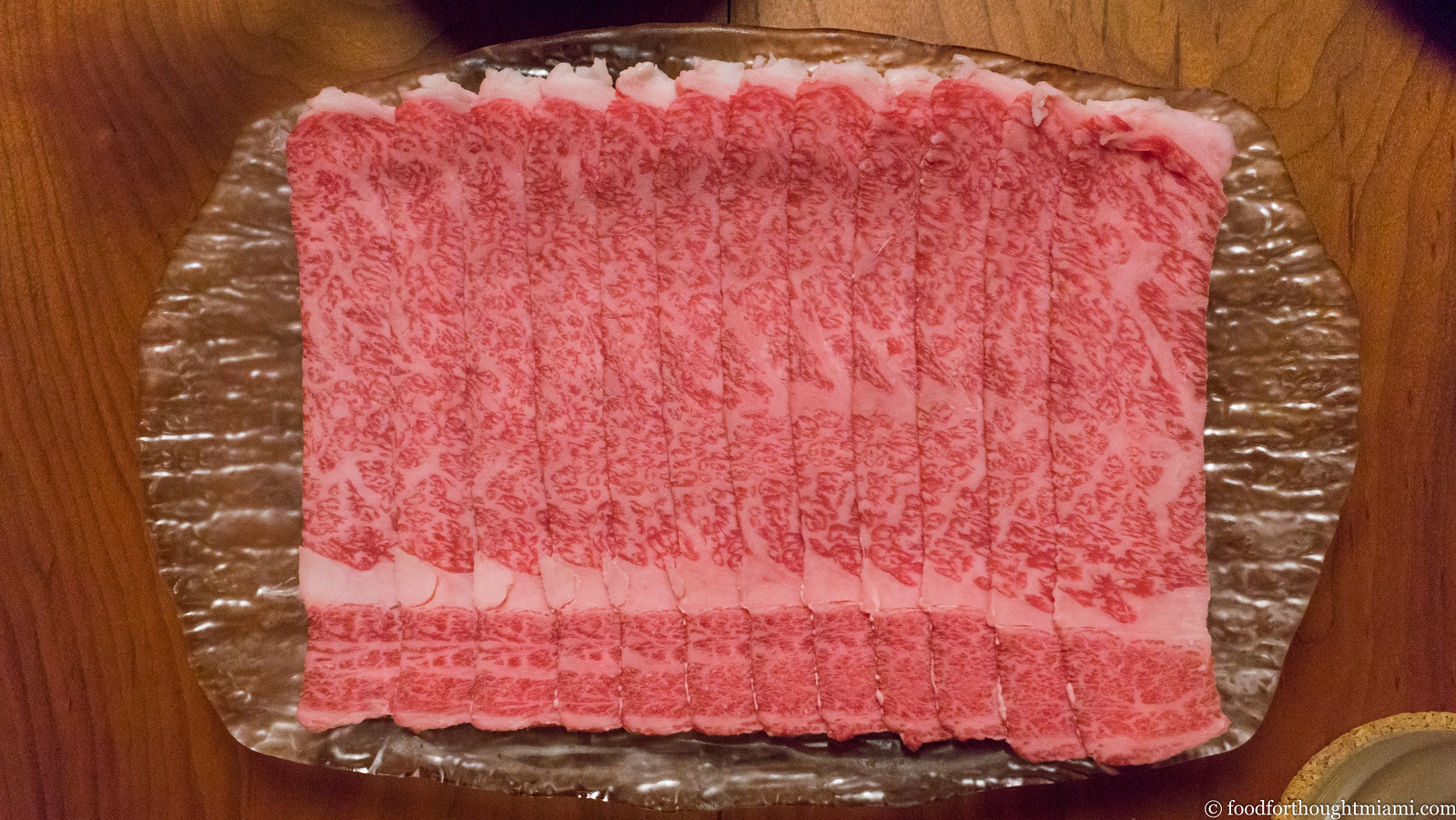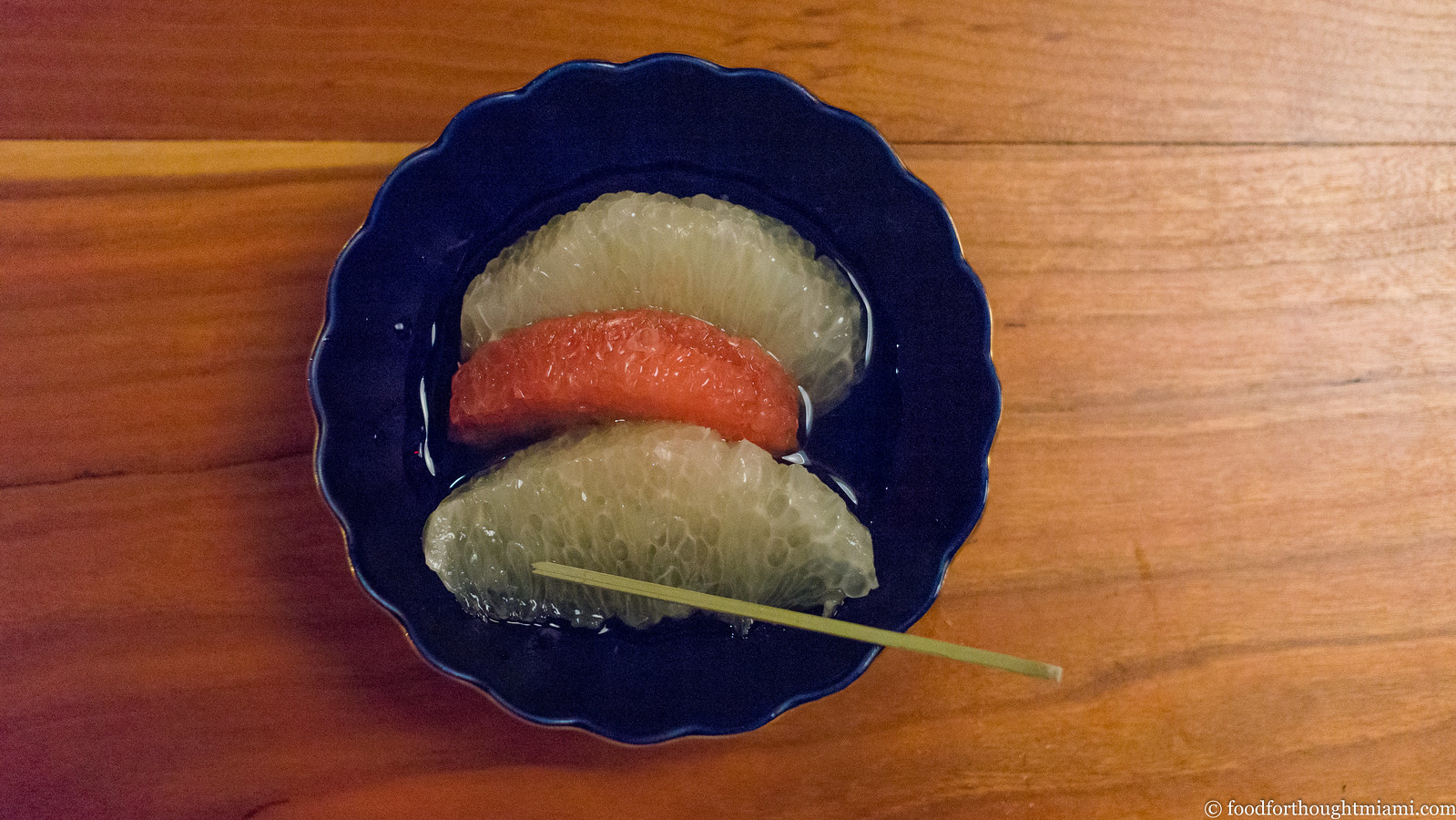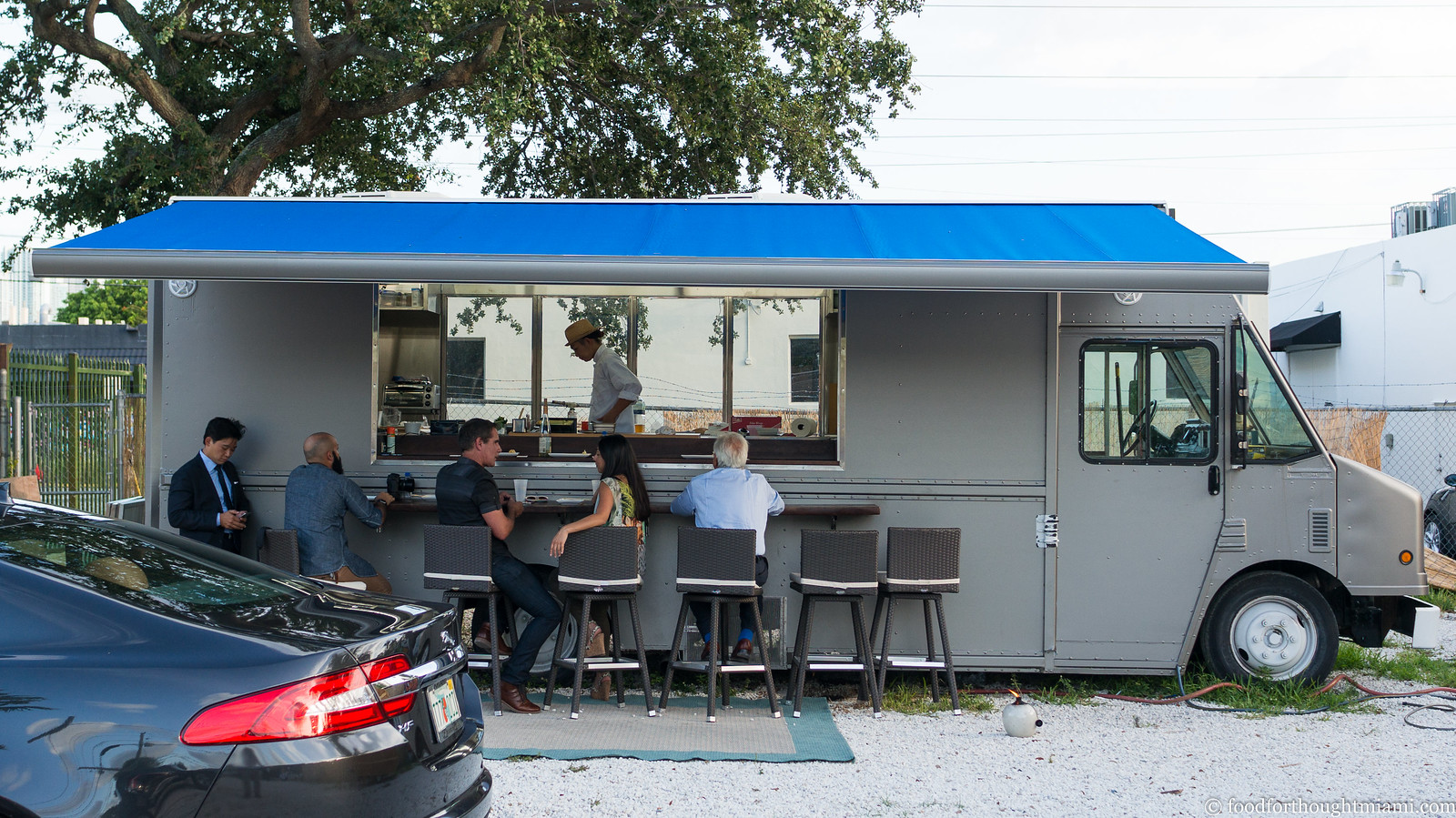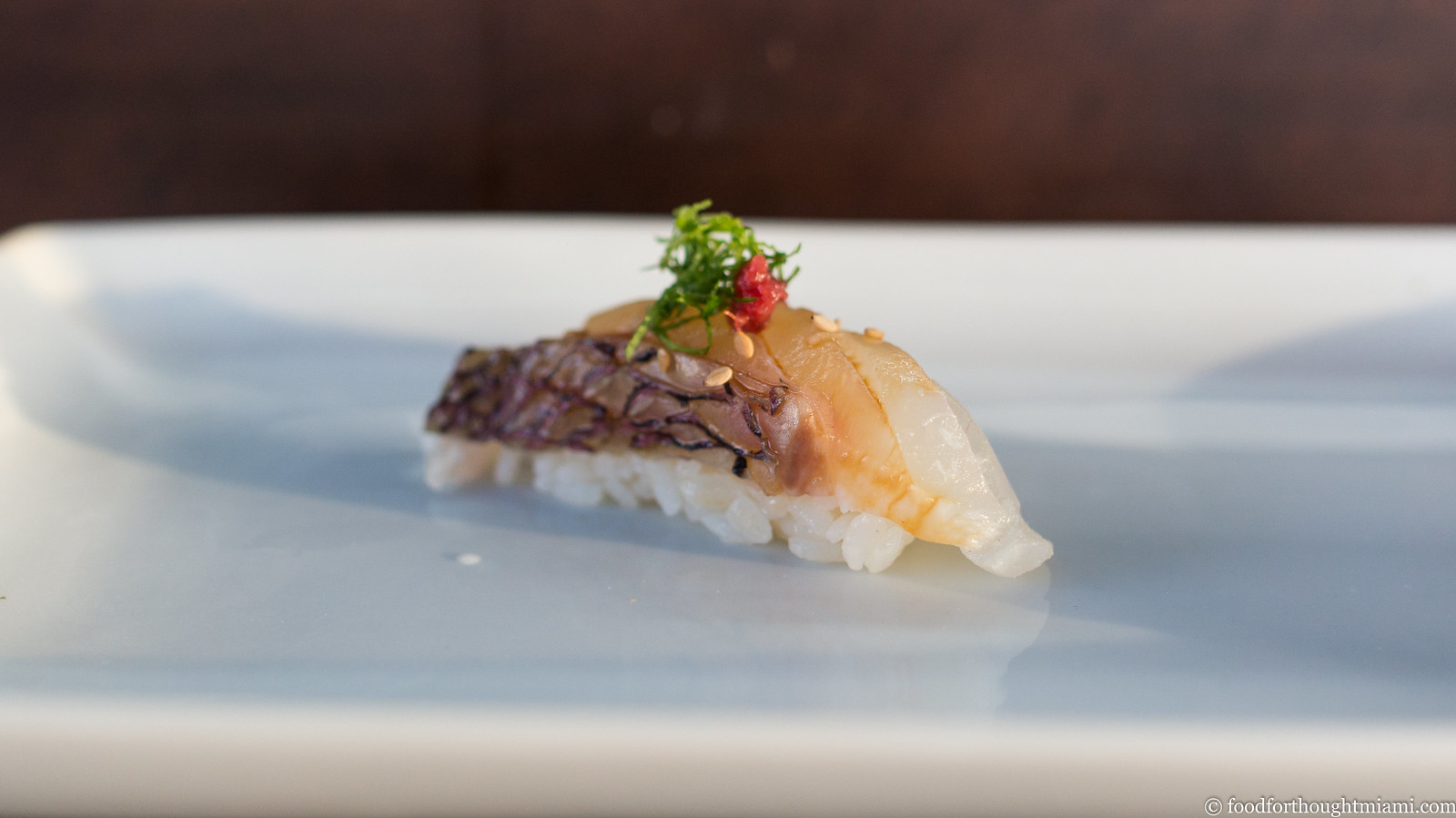About a year and a half ago, I sung the praises of Cake Thai Kitchen, a tiny spot in Miami's Upper East Side opened by chef Phuket Thongsodchareondee (a/k/a "Cake"). From this little hole in a wall, Cake was putting out some of the best Thai food I've eaten in this city. This was not the "regulation issue" menu of so many other local Thai spots; Cake offered some boldly-flavored street foods, executed with that percussive attack of spicy / sour / salty / bitter / sweet / herbaceous that brings such joy when Thai food is properly done.
The only thing I couldn't unreservedly recommend about Cake was its location. It was actually great for me personally, a few miles from home and literally just a one-block detour from my usual commute. But despite some new upmarket neighbors – Paulie Gee's on the next block, The Anderson around the corner – this particular stretch of Biscayne Boulevard remains somewhat dodgy, and the utilitarian-at-best venue might not be everyone's idea of a night out on the town.[1] If I wasn't solo, it was usually a take-out option for me too.
Well, now you can have your Cake and eat there too. [Go ahead, just kill me now].
A second Cake Thai has opened in trendy Wynwood, just off the "gateway" corner of 29th Street and NW 2nd Avenue. I made my way over there for lunch just before the new year (see all my pictures in this Cake Thai - Wynwood flickr set).
It won't be mistaken for the Four Seasons, but the dining room, with seating for about 30, is bright and airy, the walls covered with white tiles, the ceiling festooned with upside-down woven baskets for decoration.
The opening menu at Cake Wynwood is abbreviated in comparison to the original location: about thirty dishes, roughly half as many as on the Biscayne Boulevard menu. It's something of a "greatest hits," but also includes some items that were semi-regular blackboard specials at the mothership (the chive cake with chili vinegar and dark soy sauce, the chicken in red curry with pickled bamboo shoots). There's also at least a few things that are completely new, at least to me: a duck larb, some new soups and large format dishes.
The new kitchen gives Chef Cake a little more room to play, and so we can expect some more in-house pantry items to be making their way onto the menu. His nuea dad deaw – dried and fried beef jerky, made here with rich, fatty brisket buried under an avalanche of crispy fried shallots – is served with house-made sriracha sauce and pickles.
I never order pad thai. I'll invariably pick at it if the kids order it, and invariably be disappointed. Until I tried Cake's, which brings the proper balance of sour and spicy and funky to a dish that is usually just insipidly sweet. Some plump, fresh head-on shrimp also help elevate the dish. Fresh bean sprouts add crunch.
(continued ...)
Showing posts with label first thoughts. Show all posts
Showing posts with label first thoughts. Show all posts
Friday, January 6, 2017
Tuesday, December 6, 2016
first thoughts: Olla | Miami Beach
I have always had a particularly soft spot in my heart for good Mexican restaurants. I'm not talking about taquerias, though I have another very soft spot for those too. Rather, I mean higher end restaurants that treat Mexican cuisine with reverence and genuine curiosity rather than an excuse to blanket everything in melted cheese and decorate with piñatas and sombreros. I don't remember much about my long-ago college years, but I fondly recall such a place on the outskirts of Atlanta called Mexico City Gourmet.[1] Even after a couple decades, I can still taste in my mind the outstanding duck fajitas they made at a spot called Las Puertas on Giralda Avenue in Coral Gables, and the gorgeous chiles en nogada that would occasionally turn up as a special.
So when I saw a preview menu for Olla, a new restaurant which opened last week from chef Scott Linquist (who also runs Wynwood's Coyo Taco), I was pretty excited. Far from the garden variety selection of tacos, burritos and enchiladas, here's something creative and different that explores the variety of flavors of Mexico: chapulines and huitlacoche and menudo, a kaleidoscope of chiles, four different kinds of moles. Yes, I could really get into this.
We popped in at noon this past Sunday, just as they were opening the doors, to try it out for a pre-Art Basel brunch.[2] (You can see all my pictures in this Olla Miami - South Beach flickr set).
The menu leads off with several "tarros," or jars, with a variety of different layered compositions inside. You hear so often these days about dishes "designed for sharing," when they are really nothing of the sort – either a few measly bites, invariably in a number not divisible by the number of diners at the table, or something so preciously constructed as to be impossible to split. These tarros are truly designed for sharing, and do it well.
The "remolacha" has cubes of garnet and golden beets nestled over a walnut cream, topped with jewel-like pomegranate seeds and toasted walnuts, served with spears of pale endive. Scoop some into an endive spear; crunch; repeat. I liked how the combination of walnut and pomegranate echoed the traditional toppings for that chiles en nogada dish ingrained in my memory so many years ago.
Maybe even better was the "ahumado," with hot smoked salmon, chunks of boiled egg, crema, a dark green poblano-tomatillo salsa, and a dollop of salmon roe, with soft toasted bolillo bread soldiers for dipping.
Another section of the menu is given over to masa in various forms (supplied, I believe via masa maestro Steve Santana of Taquiza). We tried the gordita, similar to a Colombian arepa, split and stuffed with duck carnitas rubbed with pasilla Oaxaca chiles, and sauced with an orange-kumquat marmelada which ran a little too sweet for me. There's also a sweetbread sope, a skirt steak huarache, and a chicken tamal with mole coloradito.
"Olla" means "pot" in Spanish, and another section of the menu is given over to more than a half-dozen different dishes all served up in this fashion. Some are stews, like this rich, sticky menudo chock full of tripe, pork, and hominy in a red chile broth, topped with a fried egg and a garnish of chicharrones. There's also frijoles charros – cowboy beans – enriched with pork belly and cheek. There are also vegetables dishes, like huitlacoche (corn fungus) with wild mushrooms, toasted garlic, arbol chiles, queso fresco and epazote; and esquite, seared corn with the typical Mexican accompaniments of morita chile, mayo, cotija cheese and lime.
(continued ...)
Tuesday, September 20, 2016
first thoughts: Phuc Yea | MiMo District (Miami)
It's hard for me to believe it's been five years.
But it's been almost exactly five years to the day since I checked out a curious little pop-up restaurant in a non-descript café in downtown Miami. September 8, 2011 was opening day for Phuc Yea!, a little experiment in Vietnamese flavors by Aniece Mienhold and Cesar Zapata, the team who had previously been at a fun little spot in Buena Vista called Blue Piano. (You can read the report here and see more pictures in this flickr set.) I came away pretty excited by what they were doing: banh cuon so good we immediately ordered two more rounds; tasty salt and pepper smelts; a salad of pig ears marinated in nuoc cham, then fried crisp and served over cubed watermelon; chewy pork riblets with a soy caramel glaze.
That was five years ago. The Phuc Yea pop-up had its three-month run. Then Cesar and Aniece went on to do something different, opening The Federal, which they styled as a "Modern American Tavern," serving buffalo pig wings, creamy duck rillettes topped with marshmallow fluff, and biscuits so good that Williams-Sonoma started selling them. (You can read my thoughts on The Federal here).[1]
But, like me, they never forgot about Phuc Yea, and never gave up on the idea of reviving it. That idea became reality this past week, as they opened a new Phuc Yea in a permanent home in the "MiMo District."
This one is all grown up, in a beautiful bi-level space in an Art Deco style building along Biscayne Boulevard.[2] There's a raw bar and small lounge with a few tables at the entrance, some more tables outside, and upstairs, a dining room with moody, dramatic lighting and another big, welcoming bar, plus plans in the works for an outdoor patio in the back when the weather cools off.
(You can see all my pictures in this Phuc Yea - Miami flickr set).
The menu brings back many of the dishes from the original pop-up, plus several new items too. Most notably, there's now a raw bar featuring oysters on the half shell with a lemongrass and ginger mignonette, a daily crudo, steamed gulf shrimp and lobster, which can be ordered a la carte or as a seafood tower. There's also a "cajun wok" section of the menu, inspired by the hybrid Vietnamese/Cajun crawfish boil restaurants which seem to have originated in Houston and are catching on elsewhere (some good background on the phenomenon in this Southern Foodways video and this piece by Robb Walsh). You can get crab, shrimp, clams, or in season, crawfish, served up with a choice of sauces: cajun, green curry, garlic butter, or chili garlic.
We started with an old favorite, the banh cuon, or pork rolling cake: chewy wide rice noodles, swimming in nuoc cham, that Vietnamese elixir of fish sauce, citrus, garlic and chiles that winds its way like a Bootsy Collins bass line through so many dishes here,[3] garnished with savory ground pork, nubs of cha lua sausage, earthy wood-ear mushrooms, funky dried shrimp, fresh cucumbers and cilantro. It still hits all the right spots for me. So did the meaty, chewy pork riblets, which now also get smoked for an extra layer of flavor.
For something new, I really enjoyed a simple, bright, clean dish of fresh mango and chunky cucumber, tossed with slivered red onions, toasted garlic, dried chiles, bean sprouts and herbs. A light wash of nuoc cham intensifies the flavors, like salting a slice of watermelon. This is a great thing to cut the richness of a buttery seafood boil or a big steak.
(continued ...)
Wednesday, July 27, 2016
first thoughts: All Day | Downtown Miami
Most of the time, I skip breakfast. I know, they say you're not supposed to, most important meal of the day, blah blah blah – but a cup or two of my inartfully home-brewed coffee first thing in the morning and I'm usually good to go. And yet, I actually love breakfast foods, especially those on the savory side of the aisle: eggs, toast, bacon, sausage – these are all wonderful delicious things. And I'll gladly eat them any time of day.
So I was pretty excited when I heard about All Day, a spot that recently opened in the "Arts & Entertainment District" on the northern edge of downtown Miami. The concept is pretty straightforward: good coffee and egg dishes, served all day. I was even more excited when I learned it was run by Camila Ramos, the talented barista and former head of Panther Coffee's retail operations.
The coffee menu at All Day – posted on the wall in green neon behind a massive Marzocco espresso machine – is a bit enigmatic and designed to foster a conversation. "01 - Double Shot" is straightforward enough, a double shot of straight espresso (pulled with Ruby Coffee Roasters' Creamery Blend; the Panther alumnae is now a free agent and uses beans from several different roasters). But "02 - & Milk" requires some more user input: what's your preferred ratio of milk to coffee, do you like your milk foam wet or dry?
(You can see all my pictures in this All Day - Miami flickr set).
The ten choices also feature drip, pour-over, and cold brew coffees, including a nitrogen gas infused version with the thick, frothy texture of a well-pulled Guinness; esoterica like "Royal Tea" (an infusion of coffee cherry husks and evaporated milk, also given the nitro treatment); and a rotating daily special (currently a concoction of cold brew and rosemary limeade).
I am not really a coffee geek, and won't pretend to be. So I can't tell you much other than that the espresso I had on my first visit was bright and rich and creamy; the "& Milk" I had on my next visit, with a 2:1 espresso:milk ratio (in Miami we'd call this a cortadito; in San Francisco you might call it a "Gibraltar"), was even better. I usually drink my coffee black, but the short pour of milk nicely tempered the acidity of the coffee.
Can we talk about something I actually know something about?
The food menu at All Day, created by chef Charles Lutka, who ran Gigi for the past five years, is very egg-intensive. There are three variations on the theme of breakfast sandwich. The first of these, the "Runny & Everything," combines a sunny-side-up fried egg with a couple slices of bacon, sharp cheddar cheese, lettuce, and a thick slab of tomato, all served on a puffy, everything-spice dusted brioche bun. Though nominally a sandwich, this is – as the name warns – a gooey, fork and knife affair. It was a good combination; I think a sturdier bread might give it a little more architectural integrity, something more up to the task of sopping up that runny yolk.
The Pan Con Croqueta was another tasty combination that I wound up giving the Costanza treatment. A variation on a Cuban breakfast staple, this sandwich was anchored by a couple plump, crisp-edged pork croquetas, resting atop a runny, green-hued, herb-flecked egg spread, with some gouda cheese for a little extra creaminess and thin-sliced pickles for some tart contrast. Even the sturdier Cuban bread couldn't quite hold together the runny egg salad, though this was another delightfully happy mess. I suppose if I want to keep my hands clean, I should try the "One Handed" next.
(continued ...)
Friday, June 3, 2016
first thoughts: Doce Provisions | Little Havana (Miami)
I'd been meaning to ask Burger Beast, who is my expert on such things, what was his favorite Cuban sandwich in Miami. Then I found myself driving through Little Havana on the way back from court yesterday, and may have come up with my own answer to that question.
Doce Provisions is a pocket-sized restaurant on SW 12th Avenue, just a couple blocks north of Calle Ocho. (The spot used to be Alberto Cabrera's Little Bread). There's not much to it: a few tables, a counter along the wall lined with stools, and an open kitchen, though a roomier patio in back provides outdoor seating if weather permits. The menu is pretty tight too: the centerpiece is five varieties of sandwiches, bookended by several appetizer type items "para picar," and five bigger "family meal" options, all available in small or large portions.
(You can see all my pictures in this Doce Provisions flickr set).
The crumbly exterior of Doce's croquetas encases a filling of Miami Smokers[1] chorizo bound in a molten bechamel sauce. These would hold up well in a croqueta showdown with just about any others in town, save maybe Michelle Bernstein's ethereal versions. At $5 for four pieces, that's not too shabby. And while a "mostaza" dipping sauce tastes more of mayo than mustard, a delicate little side salad of frisée and slivered pickled peppers provides exactly the zing I was looking for.
It's a solid opening act to the main event: Doce's El Cubano. This Cuban sandwich is unorthodox in several respects. There's thin-sliced smoked pork loin and cured soppressata here, versus the traditional roast pork and ham.[2] The bread is neither the customary, flaky Cuban bread nor the sweet, eggy medianoche variation, but lies somewhere in between: the crumb more tender than the former, the crust a bit more substantial than the latter.
(continued ...)
Monday, May 16, 2016
first thoughts: Dragonfly Izakaya | Doral
Nearly a year ago, I posted some thoughts prompted by an Eater "Future Week" feature on the future of Miami dining. One of the things I predicted was that we would start seeing more independent restaurants in less trendy neighborhoods: places like Doral and Kendall, with lower rents, lots of potential customers, and not much competition other than chains. I'll confess that as a Miami Beach resident, I don't get out that way very often (honestly, I'd usually rather chew off one of my own limbs than drive on SR-836 West). But I braved the westward traffic last week to pay a visit to Dragonfly Izakaya, which opened last month.[1] The menu, which promised seafood from Tsukiji Market and robata-grilled "neck to tail" yakitori, had lots of the right words on it.
(You can see all my pictures in this Dragonfly Izakaya and Fish Market flickr set.)
It's a big venue, with a long and busy indoor/outdoor bar, seating for probably about 100, and an open kitchen with a robata grill and sushi bar. At the entrance is a small space that's slated for use as a fish market, though it's not yet up and running. Dragonfly's a good-looking room, which incorporates Japanese elements into the design – big sake barrels, wooden planks over the robata grill with the menu written in kanji – but not in a completely over-the-top Epcot kind of way.
We started at the bar, which during happy hour features $7 cocktails (including a nice pre-batched Old Fashioned) and several sub-$10 snacks, including a solid rendition of chicken karaage for $5 (that's not the entire portion – someone ate half of it before I got there). After the happy hour clock wound down, we shifted our way over to the sushi bar to sample through the rest of the menu.
We started with a round from the robata grill. The selection was not as broad as the menu promised: a "Neck-to-Tail Tasting Menu" listed several of the more exotic chicken bits, but some of my favorites were not yet available: bonjiri (chicken butt, from the end of the tailbone), seseri (neck, with lots of nice crispy skin) and tsukune (ground chicken meatballs, not sure why these would be so difficult to drum up). But we still did OK – pictured here and working clockwise from top left, eryngii (king oyster mushrooms) doused with butter and lemon, reba (chicken liver) swiped with tare, kawa (crisp, fatty chicken skin), and shio saba (salted mackerel). In the bottom left corner is one of my favorites, okonomiyaki, a sort of savory Japanese pancake studded with cabbage and seafood, then bedecked with Kewpie mayo, okonomi sauce, aonori, beni shoga (red pickled ginger), and wispy bonito flakes. Off-screen: tontoro, grilled pork cheek, served with a nutty sesame oil dipping sauce.
Of these, the highlights were the saba – it was powerfully salty, but the mackerel was tender, oily and fishy in a welcome way – and the okonimiyaki, a treat that's difficult to find here in Miami. The chicken items were good, but lacked that fantastic balance of juicy and crisp that I've experienced at yakitoris in Japan (though that's setting the bar pretty high).
We followed with a round of nigiri: here, from back to front and left to right, hamachi (yellowtail), saba (mackerel), hotate (scallop), ika (squid), ikura (salmon roe), and mirugai (geoduck). Off-screen: ama ebi (sweet shrimp), served in the customary fashion accompanied by their fried heads. Again, the offerings on hand were a bit shy of what was listed on the menu: no o-toro, uni or aji. no kinmedai or aji from Tsukiji market. But from what we sampled, the fish was of pretty good quality – I especially enjoyed the firm snap of the mirugai. The rice was a bit cold, stiff and underseasoned for my taste. The chef also sent over a tuna kobashi for us to sample, with ruby-hued cubes of fish given a riveting dash of kimchi spice and a savory hit of toasted sesame oil, served with slivered avocado and airy rice crackers for some DIY Japanese nachos.
(continued ...)
Tuesday, March 8, 2016
first thoughts: Plant Food + Wine - Miami (Wynwood)
Skeptical. Doubtful. Dubious. Let's just say I wasn't really so sure that I'd enjoy a restaurant committed to an entirely vegan, raw menu. It's not that I'm opposed to vegetables – I love them. But as an unrepentant omnivore who cares about flavor first and foremost, I'm wary of any dogma that would keep huge categories of delicious edible things off my plate, and even more suspicious of the notion that none of the things on that plate should be cooked.
But that's the thinking behind Plant Food + Wine, Chef Matthew Kenney's new restaurant in Miami's Edgewater neighborhood.[1] Kenney is a chef and "lifestyle" guru who also runs The Gothic in Belfast, Maine as well as another Plant Food + Wine in Venice, California. He has published several books and hosts "Culinary Academies" to teach plant-based cooking techniques, all under the tagline of "crafting the future of food."
Pleasantly surprised. That's how I felt after my first meal at Plant. Despite an entirely vegan menu where no food is heated beyond 110° (and maybe even in some instances because of that commitment), the food at Plant was mostly quite delicious. Somewhat uncharacteristically for a restaurant that is in a sense defined by what it chooses not to serve, there's as much attention paid to flavor and presentation as there is to principle. And that's a welcome distinction.[2]
(You can see all my pictures in this Plant Food + Wine flickr set).
The place itself is a stunner. It's on a gigantic lot with a sprawling patio bisected by a blue-lit wading pool, surrounded by towering date palms. There's as much seating outside on the deck as there is inside the dining room, which feels open and breezy thanks to its double-height ceiling, bright white open kitchen,[3] and retracting glass doors that open the indoor and outdoor spaces up to each other.
The menu features several smaller items "for the table," followed by about eight "small plates" and around the same number of "mains," with most smaller plates priced in the low teens and larger plates hovering around the $20 mark. We ordered a couple of items from each section of the menu.
I've often puzzled over why so much plant-based food feels like penance. Vegetables can be so bright and colorful, yet so much vegan food – all the "field roasts" and "chik'n" and their ilk – looks like processed pet food. That's not the case at Plant, where vegetables are rightly celebrated.
Kimchi dumplings feature bright green translucent wrappers wrapped around a nutty filling, with even brighter beet-dyed magenta swooshes adorning the plate. I’ve gradually come around to Gael Greene’s conclusion that most foams are “insipid,” but here's one that actually tastes pointedly of ginger and contributes a nice accent to the dish. Banh mi lettuce wraps, another item "for the table," actually use deep-green collards for their casing, which are filled with a smoked chili-almond pate, crunchy napa cabbage, and slivers of pickled daikon radish and red peppers.
A sunflower caesar salad uses both crunchy romaine and peppery arugula, dressed in a thick sunflower seed dressing with a rich, tahini-like flavor.[4] Sunflower seeds play the role of croutons; briny capers even more effectively play the role of the traditional anchovies. It happens to be a great salad, mixing both bright and deep flavors and a bunch of nice textures.
A small plate of romanesco cauliflower, lightly cooked to soften its raw edge, is tossed with a tangy salsa verde, served over a rich toasted pepita cream, and laced with ribbons of preserved lime. More good flavors: but I wished it had been given another pinch of salt and that the preserved lime had more prominence.
The MK Bowl pictured at the top is listed in the “mains” – and I have to confess that while I have no opposition to salads generally, I often struggle to think of them as a main course to a meal. But this achieved a certain substantiality, combining delicate lettuces with heartier shaved root vegetables, creamy avocado, fresh sprouts, grassy carrot greens, and crunchy hemp seeds, all lightly bound with a tangy, savory lemongrass tahini dressing. I might have wished for the sunflower-chia seed “croutons” to have more crunch, instead of the texture of wet paper, but everything else here worked.
(continued ...)
Monday, February 22, 2016
first thoughts: Ichimi Ramen, Coral Gables
There are so many new restaurants opening in Miami these days that I have given up on the prospect of keeping current with all of them. In fact, I've somewhat happily resigned myself to the opposite: I'll just wait six months, and a good number of them will have already closed.
Still, amidst this latest wave, there are some good things happening. I was sad to see Little Bread (formerly Bread & Butter) close in Coral Gables as Chef Alberto Cabrera heads off to Las Vegas, but was happy to see a promising-looking replacement coming into the space; Ichimi Ramen. Ichimi is a ramen-ya and izakaya run by Chef Constantine DeLucia, who previously worked at Momi Ramen as well as Lure Fishbar and Estiatorio Milos. I've already been in there twice since it opened a couple weeks ago.
Like Momi, Miami's only dedicated ramen specialist, the noodles are made in-house. The prices are also close but not quite at Momi-esque levels (depending on contents, ramen bowls run $18-22),[1] though at least they take credit cards so you don't need to bring a wad of cash. The menu currently features four styles of ramen (tonkotsu, seafood, veggie, and beef brisket) as well a few cold ramen dishes. They are planning to do tsukemen (plain noodles served with an intense dipping sauce on the side rather than in broth), but it wasn't yet being served on either of my visits.
(You can see all my pictures in this Ichimi Ramen flickr set).
The first bowl I sampled was their veggie ramen, and it was great: a focused, flavorful shoyu broth (that I assume starts with a kombu dashi) stocked with shiitake and nameko mushrooms, bamboo shoots, bean sprouts, and a bouquet of pea shoots and tiny greens. The noodles are simultaneously hardy and supple, with a nice spring to them. It brought back memories of one of the first and still best bowls I had at Momi, a vegetarian ramen I've never seen on the menu there since. I've also tried Ichimi's tonkotsu ramen, which was good but not a show-stopper: the slabs of pork belly were delicious, but the broth lacked that lip-sticking unctuousness that typically characterizes the long-cooked pork bone elixir.
Ichimi also offers a pretty extensive menu of "izakaya" type small plates, most of which are much more ambitious and chef-y than your average izakaya. Maybe the best example is this "uni taco," which cleverly uses a tempura-fried nasturtium leaf as the tortilla, then tops it with a slice of wagyu beef, a couple lobes of tender, bright-orange sea urchin, and a spray of shiso "air, with a final garnish of purple micro-shiso and more pea tendrils.
(continued ...)
Still, amidst this latest wave, there are some good things happening. I was sad to see Little Bread (formerly Bread & Butter) close in Coral Gables as Chef Alberto Cabrera heads off to Las Vegas, but was happy to see a promising-looking replacement coming into the space; Ichimi Ramen. Ichimi is a ramen-ya and izakaya run by Chef Constantine DeLucia, who previously worked at Momi Ramen as well as Lure Fishbar and Estiatorio Milos. I've already been in there twice since it opened a couple weeks ago.
Like Momi, Miami's only dedicated ramen specialist, the noodles are made in-house. The prices are also close but not quite at Momi-esque levels (depending on contents, ramen bowls run $18-22),[1] though at least they take credit cards so you don't need to bring a wad of cash. The menu currently features four styles of ramen (tonkotsu, seafood, veggie, and beef brisket) as well a few cold ramen dishes. They are planning to do tsukemen (plain noodles served with an intense dipping sauce on the side rather than in broth), but it wasn't yet being served on either of my visits.
(You can see all my pictures in this Ichimi Ramen flickr set).
The first bowl I sampled was their veggie ramen, and it was great: a focused, flavorful shoyu broth (that I assume starts with a kombu dashi) stocked with shiitake and nameko mushrooms, bamboo shoots, bean sprouts, and a bouquet of pea shoots and tiny greens. The noodles are simultaneously hardy and supple, with a nice spring to them. It brought back memories of one of the first and still best bowls I had at Momi, a vegetarian ramen I've never seen on the menu there since. I've also tried Ichimi's tonkotsu ramen, which was good but not a show-stopper: the slabs of pork belly were delicious, but the broth lacked that lip-sticking unctuousness that typically characterizes the long-cooked pork bone elixir.
Ichimi also offers a pretty extensive menu of "izakaya" type small plates, most of which are much more ambitious and chef-y than your average izakaya. Maybe the best example is this "uni taco," which cleverly uses a tempura-fried nasturtium leaf as the tortilla, then tops it with a slice of wagyu beef, a couple lobes of tender, bright-orange sea urchin, and a spray of shiso "air, with a final garnish of purple micro-shiso and more pea tendrils.
(continued ...)
Thursday, December 24, 2015
first thoughts: Pao by Paul Qui in the Faena Hotel - Miami Beach
Of the many big-name Miami restaurant openings of late, the one I've been most curious about is Paul Qui's Pao in the Faena Hotel Miami Beach. I've followed the chef since he was in the kitchen at Austin's Uchi, watched him dominate a season of Top Chef and win a James Beard Award in 2012, then go on to open both a tasting menu format restaurant (Qui) and several ragingly successful food trucks in Austin (East Side King and its sibling Thai-Kun, which was on Bon Appetit's list of best new restaurants of 2014).
Pao is Qui's first venture outside of Austin, and it's a big one: the Faena is perhaps the most ostentatious and over-the-top of many recent ostentatious, over-the-top Miami developments. The billion dollar project includes not only the hotel, where rooms start at $900 a night, but also a Norman Foster-designed condominium where units are selling for an average of $3,000 per square foot (including a $60 million sale to a billionaire hedge fund manager) and the Rem Koolhaas-designed Faena Forum, a multi-disciplinary arts exhibition center.
It is both exciting and, in a way, alienating. In many respects, I simply don't recognize this as the city where I was born and have spent nearly half a century. Faena, and other recent projects like the expansion of the Design District into what seems like a living catalog of the holdings of LVMH, are designed as playgrounds for the über-wealthy, international jet-set; they have little connection to the locals who actually live here.
But if it brings chefs like Qui to Miami, then who am I to complain?
Oddly, despite all the hullabaloo over Faena, details on Qui's restaurant have been somewhat hard to come by, even as it opened at the beginning of this week. I heard the food would be "modern Asian" with "Filipino, Spanish, Japanese and French flavors;" I heard a lot more about the $6 million Damien Hirst gold-leafed unicorn sculpture ("Golden Myth") that is the centerpiece of the dining room. But that's OK: so many restaurants put out so much pre-opening hype these days that I grow tired of hearing about them before they've even opened. By contrast, I didn't have much of an idea of what to expect heading into Pao. So here's a first look.
(You can see all the pictures from my first visit to Pao – including shots of the menu, which is not yet available online – in this Pao by Paul Qui flickr set).
The menu starts with four choices of fish crudos, along with a "binchotan service" featuring several items that can be grilled tableside over Japanese charcoal. It then moves through about a half-dozen choices of small plates, several rice dishes and a selection of several larger-format plates meant for sharing.
The first item on the menu points toward Qui's Filipino heritage: kinilaw, the Philippines' version of ceviche. Slices of hiramasa (a/k/a buri, yellowtail, amberjack) are bathed in coconut milk and coconut vinegar, garnished with hearts of palm and slivered red onion, and dappled with Spanish olive oil. It's richer, and less acidic, than a typical ceviche, and I found myself wishing the vinegar was turned up a little louder than the coconut milk. The other crudo we tried, a carpaccio of Japanese sea bream, was plated with a puddle of smoked soy sauce and leek oil contained within a ring of kumquat jam that tasted as bright and vibrant as its vivid orange hue. The quality of the fish was excellent, but I was somewhat surprised that of the four crudos offered, none came from local waters
(continued ...)
Monday, December 7, 2015
first thoughts: N by Naoe Shabu Shabu - Brickell Key, Miami
Since then – as Kevin recently reminded me – I was the first to write about Naoe after its move to Brickell Key three years later, and also one of the first visitors to his side venture, N by Naoe, which he opened last year alongside Naoe in an adjoining space. N by Naoe did a pretty remarkable $80 lunch service similar to the opening salvos of a Naoe dinner, presented in a multi-tiered bento box. Alas, that is what you call a "niche market."
So N by Naoe has been repurposed. Now N by Naoe does shabu shabu.
(You can see all my pictures in this N by Naoe Shabu Shabu flickr set).
"Shabu shabu" is the Japanese onomatopoeic equivalent of "swish swish" – and more specifically, refers to the sound that thin slices of beef make as they are quickly cooked via a brief splash in hot water. "Beef cooked in hot water" doesn't sound like the most exciting meal in the world; but when you start with silky, obscenely marbled Japanese beef, and combine it with beautiful fresh vegetables in a flavorful stock, you get something magical.
It starts with water: water which comes from a well on a tiny hilltop property in Kanazawa, Japan owned by Kevin Cory's family.[1] The water is warmed on a tableside burner, and a strip of dried seaweed is added to make a kombu dashi. It's simple, but kombu is loaded with glutamates (the stuff in MSG that makes everything taste better). A couple of dipping sauces – nutty sesame, and bright citrusy ponzu – are also arranged at each diner's place setting. After a few minutes of simmering, the kombu is removed, and a platter piled with vegetables is brought to the table.
For us, there were several different kinds of mushrooms – brown buttons, oysters, wood ear, enoki – as well as napa cabbage, chrysanthemum leaves, and blocks of tofu. You toss some vegetables into the pot – some of the heartier mushrooms, and the firmer bits of the cabbage can take a while, and add their flavor to the broth, while the frilly cabbage leaves and delicate chrysanthemum may need less than a minute.
Then the centerpiece is brought to the table: wagyu from Miyazaki Prefecture, thin slices of ribeye with incredible speckled fat marbling that runs through the entire steak. You have probably heard of "Kobe beef" – in fact, you have probably heard many things called "Kobe beef" that are not in fact "Kobe beef," since "Kobe beef" can only come from Kobe, Japan, and I'm pretty sure that places like Prime 112 are not paying for Japanese beef to put into hot dogs and hamburgers, even if they're sold for $25-30; but I digress. I mention this because the beef N by Naoe uses is not called "Kobe beef" because it comes from Miyazaki Prefecture, not Hyogo Prefecture where Kobe is located. But – unlike those ridiculous hot dogs and hamburgers that call themselves "Kobe beef" – this is every bit its equal. This particular sample carries an "A5" grading with a BMS or "Beef Marbling Score" of 8 on the 1-12 scale used in Japan, and was one of the most luscious steaks I've ever tasted.[2]
You take a slice of that beef. You swish it a couple times through the broth ("shabu-shabu").[3] You swipe it through one of the dipping sauces. You eat. You pluck some of the vegetables and tofu out of the pot and do the same.[4] Repeat. And repeat again, until you and your dining companion are anxiously eyeing the last slice of beef on the platter.
It's so rich that really, that one platter is enough – but sometimes enough isn't quite enough. If you understand what I mean, then you'll be glad to know that you have the option to add on an additional half-order or full order of beef. The fixed price per person for the shabu shabu is $60 per person; an additional order of beef can be had for $72, or a half-order for one person can be had for half the price.
Around the time you are closing in on that last slice of beef, the server will deliver a bowl of perfectly cooked rice. Then the pot will be scooped up and its contents buffeted with some chopped scallions and served to you as a restorative soup. It's surprisingly flavorful, imbued with the concentrated essences of the beef and vegetables which have been cooked in the broth. The one-two of rice and soup is a traditional Japanese coda to a meal that fills up and then calms your belly.
A simple bowl of fresh fruit – here, a couple different kinds of grapefruit – closes out the meal.
This is an elemental meal that depends almost entirely on its ingredients; after all, the cooking itself is being done by unskilled amateurs. But with the outstanding quality of the beef, and those gorgeous fresh vegetables, it works. It's also a lot of fun.
N by Naoe
661 Brickell Key Drive, Miami, Florida
(reservations exclusively through SeatMe 5:15-10:45pm Su-Tu, Th-Sat, and lunch 12-6pm for parties of 8 to 16)
[1] Kidding.
[2] For further explanation of the Japanese grading system, read up at the Japan Meat Information Service Center. The letter grade is based on yield; the number grade is based on quality, including marbling as well as both the texture and color of the meat and fat.
[3] Long communal chopsticks are supplied for action involving the big pot, unless you're dining with an uncouth lout who uses the communal chopsticks to feed himself. Steve insisted this is how you show dominance in shabu shabu. I think he confused it with sumo wrestling.
[4] Pro tip: though the recommended pairing is the sesame sauce with the beef, and the ponzu with the vegetables, both Steve and I preferred to reverse it. The citrus in the ponzu nicely cuts through the fattiness of the beef, while the creamy, nutty sesame sauce adds a bit of richness to the vegetables.
[2] For further explanation of the Japanese grading system, read up at the Japan Meat Information Service Center. The letter grade is based on yield; the number grade is based on quality, including marbling as well as both the texture and color of the meat and fat.
[3] Long communal chopsticks are supplied for action involving the big pot, unless you're dining with an uncouth lout who uses the communal chopsticks to feed himself. Steve insisted this is how you show dominance in shabu shabu. I think he confused it with sumo wrestling.
[4] Pro tip: though the recommended pairing is the sesame sauce with the beef, and the ponzu with the vegetables, both Steve and I preferred to reverse it. The citrus in the ponzu nicely cuts through the fattiness of the beef, while the creamy, nutty sesame sauce adds a bit of richness to the vegetables.
Monday, June 1, 2015
first thoughts: Myumi Omakase Sushi Truck - Miami (Wynwood)
For a long time, I've been bemoaning the dearth of good sushi in Miami. I'm not even talking about in comparison to what I had in Japan; just good quality fish and properly prepared rice is frustratingly difficult to find.
On the very high end there is Naoe, but it requires a commitment of at least a couple hundred bucks and a few hours. I'm also a fan of Makoto in Bal Harbour, but it's become a difficult reservation many days. I've actually got an excellent little spot in my neighborhood, but it's so small, its hours are so limited, and it's become so popular that it is now the Sushi Bar That Shall Not Be Named.
Then what? I had a good meal when I went omakase at Morimoto (pictures here), but the sushi wasn't really the highlight. A few years ago I made a return to Nobu after several years away and the sushi was reasonably good, but the value was entirely out of whack, as has always been the case there. I was actually pleasantly surprised by my first visit to the recently opened Soho Bay (pictures here), a Brazilian import that poached a Nobu alum, Ricardo Sauri, for its executive chef. I'll have to go back and try more.
What else? I'm not nearly as enamored of Matsuri as some folks are. I've got a couple izakayas I love – Hiro's Yakko-San and Su Shin – that serve sushi, but it's not their strong suit.[1] I'll go to Pubbelly Sushi for their reimagined Japanese gastropub stuff – a good rendition of tuna poke, the hamachi ceviche with tostones, the ridiculous but delicious pork belly and clam roll – but it's also not a place to go to for traditional nigiri. Everything else I've tried is crap.
Enter Myumi. It's not your typical sushi bar. In fact, it's a truck – a converted FedEx delivery truck, currently stationed in a lot in Wynwood. Which I suppose makes a bit of sense: I've read that sushi was originally street food. From that truck, Chef Ryo Kato[2] serves an omakase only (chef's choice) menu with only two choices: do you want to spend $40 or $60?
The omakase-only format means they know exactly what they need to buy, so they buy some very good stuff: fish and shellfish straight in from Japan, uni and ikura from Alaska, tuna from Ecuador. Some items get just a brush of shoyu, others more elaborate garnishes. Our $60, 12-course selection went like this:
(You can see all my pictures in this Myumi - Miami (Wynwood) flickr set).
(continued ...)
Subscribe to:
Posts (Atom)

